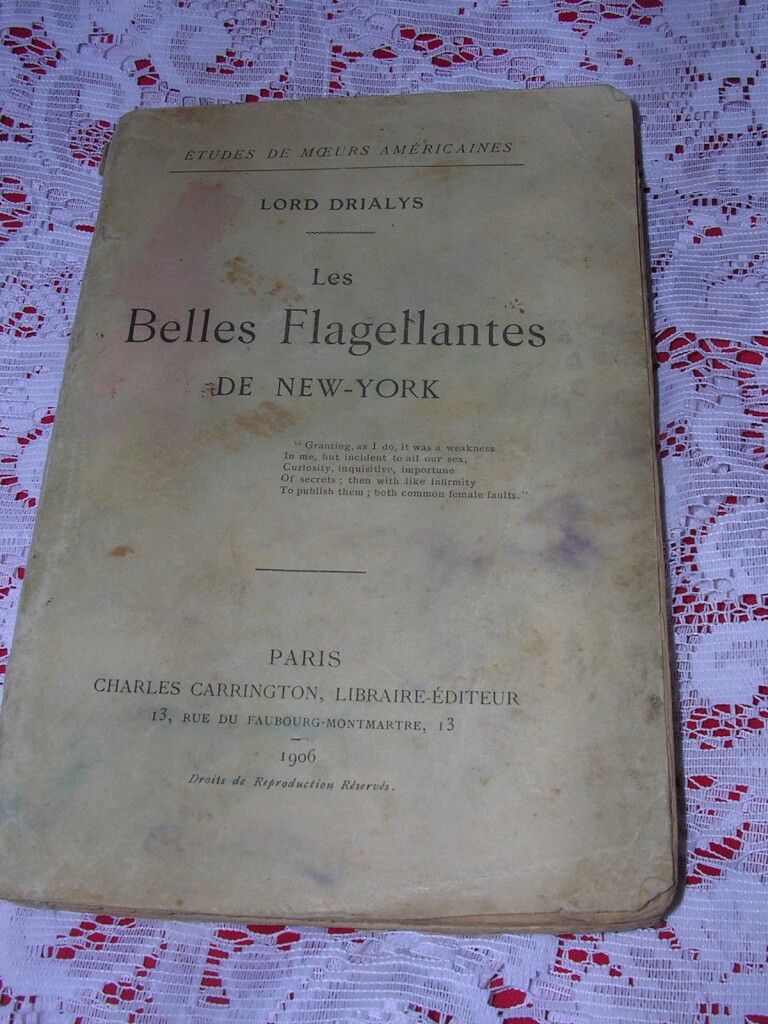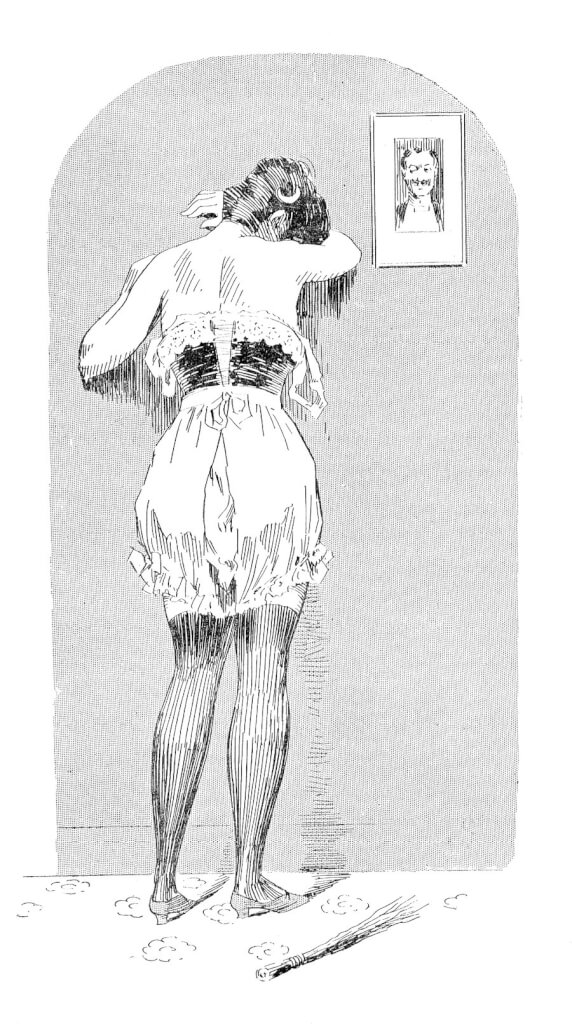Charles Carrington (1857–1921) was a leading British publisher of erotica in late-19th and early 20th century Europe. Born Paul Harry Ferdinando in Bethnal Green, England in 1867, he moved in 1895 from London to Paris where he published and sold books in the rue Faubourg Montmartre and rue de Chateaudun. For a short period he was exiled to Brussels and published there. Carrington also published “academic” works about sex and flagellation, works of classical literature and books by famous authors such as Oscar Wilde and Anatole France. It is possible that he wrote and co-wrote anonymously and embellished many of his translations and other books he published with extra salacious material and commentary.
Carrington went blind as a result of syphilis and the last few years of his life were spent in poverty as his mistress stole his valuable collection of rare books. He was placed in a lunatic asylum and died in 1921 at Ivry-sur-Seine, France.
During his 26 years in business, Carrington published nearly 300 books.
More about Charles Carrington and a bibliography of his known publications.
-
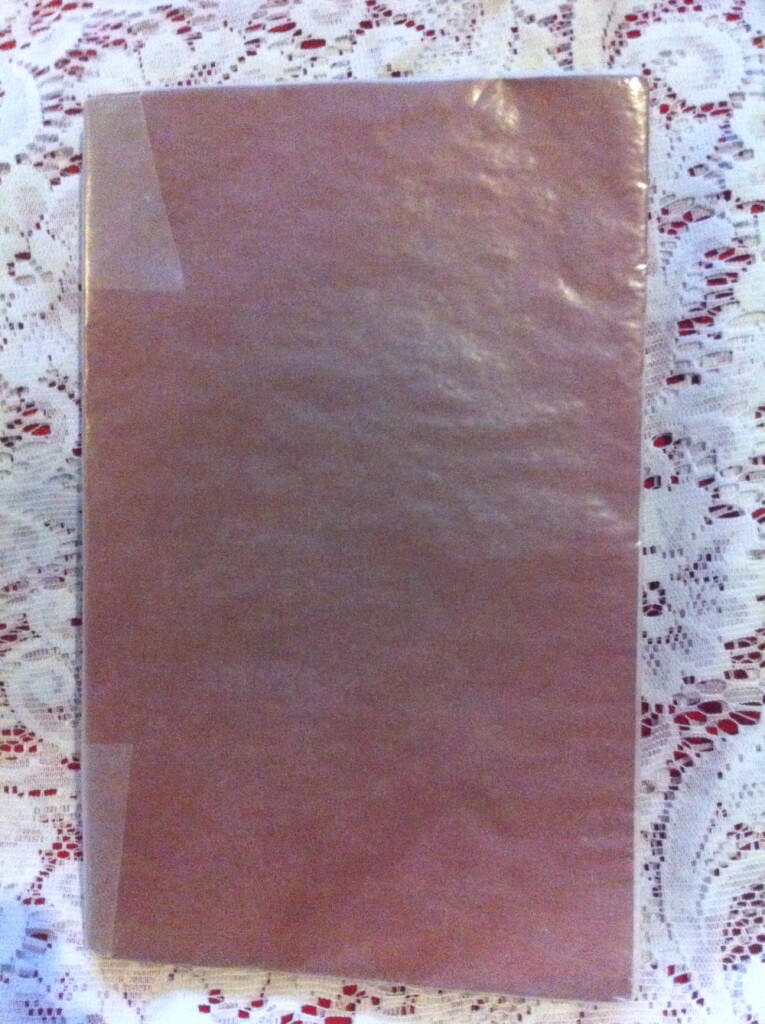
 The Old Man Young Again, or Age-Rejuvenescence in the Power of Concupiscence, [Ibn-I Kemal Pasa] "literally translated from the arabic by an English Bohemian" (Charles Carrington, Paris, 1898 [first edition]) 9" X 5.5", xi 265pp, original soft covers, unread copy (most pages uncut on top, some uncut fore edge). Protective wraps. A very rare translation of an arabic how-to sex manual with much emphasis on aphrodisiacs with a forward by Carrington. Very few copies of this Carrington publication still exist. This is particularly unique because many pages remain uncut. I know of no other copies in this unread condition!
The Old Man Young Again, or Age-Rejuvenescence in the Power of Concupiscence, [Ibn-I Kemal Pasa] "literally translated from the arabic by an English Bohemian" (Charles Carrington, Paris, 1898 [first edition]) 9" X 5.5", xi 265pp, original soft covers, unread copy (most pages uncut on top, some uncut fore edge). Protective wraps. A very rare translation of an arabic how-to sex manual with much emphasis on aphrodisiacs with a forward by Carrington. Very few copies of this Carrington publication still exist. This is particularly unique because many pages remain uncut. I know of no other copies in this unread condition! -
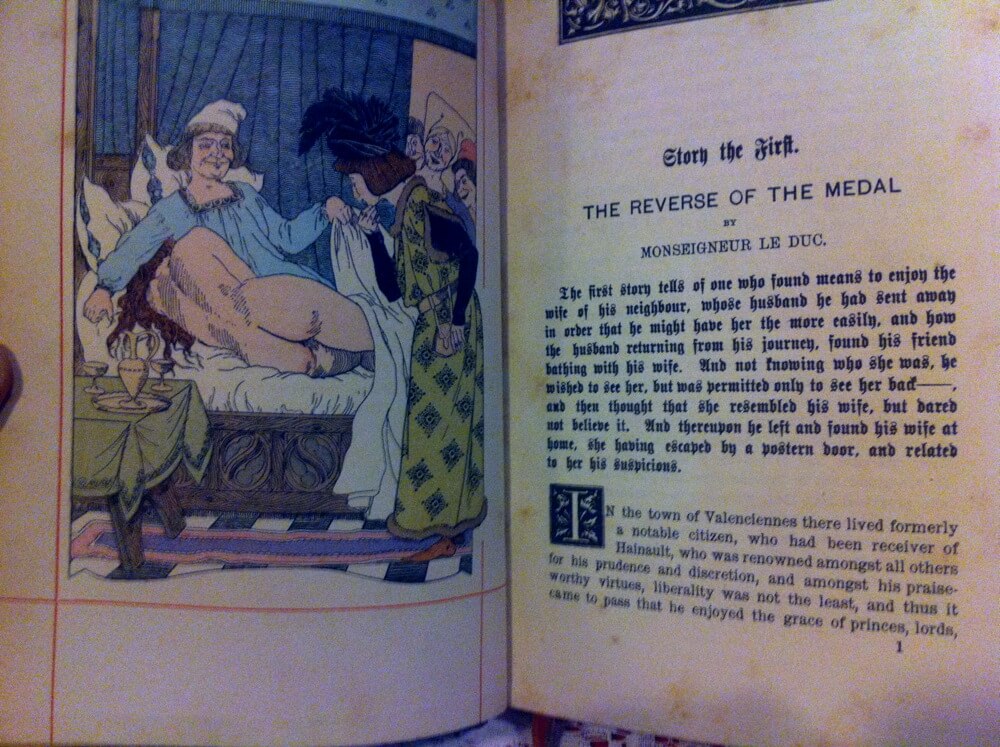
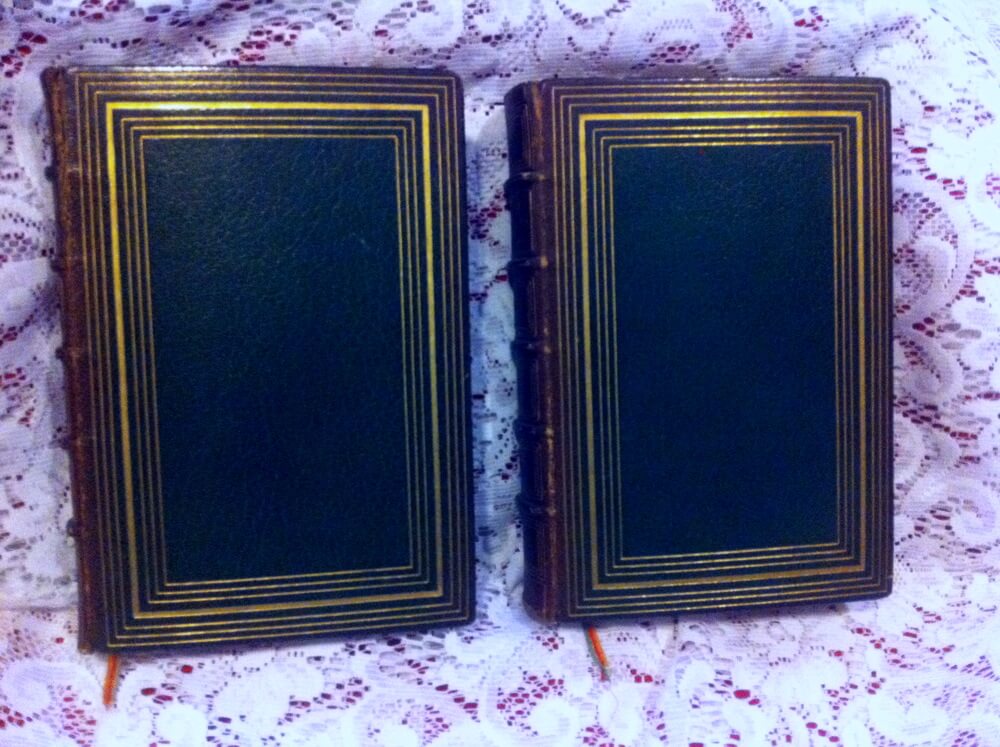 One Hundred Merrie and Delightsome Stories, ed. by Antoine de La Sale, trans. Robert B. Douglas, illust. Leon Lebegue, illust. Adolphe Lalauze (Charles Carrington, Paris, 1899 [first edition, first english translation]) 8" X 5.75", vol 1. 1-256, vol 2. 257-532, full morocco leather, olive green to maroon, gilt decorations, 5 raised bands, marbled endpapers with gilt edging on pastedowns, excellent condition for age, includes complete set of 52 hand-colored plates by Lebegue (originally sold separately) as well as complete set of 10 engravings by AD LaLuze after art by Jules Garnier, vol. 1 ribbon present but detatched, vol. 2. ribbon intact. Charles Carrington was the first to have this translated into English. This is a RARE full-leather version with ALL 52 colored plates! Also rare are the 10 engravings by LaLauze, which originally appeared in a French version. Purported a collection of short stories narrated by various persons at the court of Philippe le Bon, and collected together by Antoine de la Sale, the nouvelles are, according to the authority on French Literature—Professor George Saintsbury "undoubtedly the first work of literary prose in French ... The short prose tale of a comic character is the one French literary product the pre-eminence and perfection of which it is impossible to dispute, and the prose tale first appears to advantage in the Cent Nouvelles Nouvelles." The stories give a curious glimpses of life in the 15th century, providing a genuine view of the social condition of the nobility and the middle classes. M. Lenient, a French critic, says: "Generally the incidents and personages belong to the bourgeoisée; there is nothing chivalric, nothing wonderful; no dreamy lovers, romantic dames, fairies, or enchanters. Noble dames, bourgeois, nuns, knights, merchants, monks, and peasants mutually dupe each other. The lord deceives the miller's wife by imposing on her simplicity, and the miller retaliates in much the same manner. The shepherd marries the knight's sister, and the nobleman is not over scandalized. The vices of the monks are depicted in half a score tales, and the seducers are punished with a severity not always in proportion to the offence." For four centuries 10 of the stories were credited to Louis XI. Modern scholars have since ascribed them to either Philippe le Bel or Comte de Charolais. In all, some thirty-two noblemen or squires contributed the stories, with some 14 or 15 taken from Giovanni Boccaccio, and as many more from Gian Francesco Poggio Bracciolini or other Italian writers, or French fabliaux, but about 70 of them appear to be original.
One Hundred Merrie and Delightsome Stories, ed. by Antoine de La Sale, trans. Robert B. Douglas, illust. Leon Lebegue, illust. Adolphe Lalauze (Charles Carrington, Paris, 1899 [first edition, first english translation]) 8" X 5.75", vol 1. 1-256, vol 2. 257-532, full morocco leather, olive green to maroon, gilt decorations, 5 raised bands, marbled endpapers with gilt edging on pastedowns, excellent condition for age, includes complete set of 52 hand-colored plates by Lebegue (originally sold separately) as well as complete set of 10 engravings by AD LaLuze after art by Jules Garnier, vol. 1 ribbon present but detatched, vol. 2. ribbon intact. Charles Carrington was the first to have this translated into English. This is a RARE full-leather version with ALL 52 colored plates! Also rare are the 10 engravings by LaLauze, which originally appeared in a French version. Purported a collection of short stories narrated by various persons at the court of Philippe le Bon, and collected together by Antoine de la Sale, the nouvelles are, according to the authority on French Literature—Professor George Saintsbury "undoubtedly the first work of literary prose in French ... The short prose tale of a comic character is the one French literary product the pre-eminence and perfection of which it is impossible to dispute, and the prose tale first appears to advantage in the Cent Nouvelles Nouvelles." The stories give a curious glimpses of life in the 15th century, providing a genuine view of the social condition of the nobility and the middle classes. M. Lenient, a French critic, says: "Generally the incidents and personages belong to the bourgeoisée; there is nothing chivalric, nothing wonderful; no dreamy lovers, romantic dames, fairies, or enchanters. Noble dames, bourgeois, nuns, knights, merchants, monks, and peasants mutually dupe each other. The lord deceives the miller's wife by imposing on her simplicity, and the miller retaliates in much the same manner. The shepherd marries the knight's sister, and the nobleman is not over scandalized. The vices of the monks are depicted in half a score tales, and the seducers are punished with a severity not always in proportion to the offence." For four centuries 10 of the stories were credited to Louis XI. Modern scholars have since ascribed them to either Philippe le Bel or Comte de Charolais. In all, some thirty-two noblemen or squires contributed the stories, with some 14 or 15 taken from Giovanni Boccaccio, and as many more from Gian Francesco Poggio Bracciolini or other Italian writers, or French fabliaux, but about 70 of them appear to be original. -

 One Hundred Merrie and Delightsome Stories, ed. by Antoine de La Sale, trans. Robert B. Douglas (Charles Carrington, Paris, 1899 [first edition, first english translation]) 8" X 5.75", xxx 532pp, 3/4 tan morocco leather over marbled boards, gilt title on spine, 5 raised bands, marbled endpapers, excellent condition for age, ribbon intact, small tear at top of front cover. No illustrations One Hundred Merrie And Delightsome Stories (from the original French "Cent Nouvelles nouvelles" France, c. 1456-1461) is a collection of stories supposed to be narrated by various persons at the court of Philippe le Bon, and collected together by Antoine de la Sale in the mid 15th century. Charles Carrington was the first to have this translated into English. This edition does not contain the illustrations which were sold separately.
One Hundred Merrie and Delightsome Stories, ed. by Antoine de La Sale, trans. Robert B. Douglas (Charles Carrington, Paris, 1899 [first edition, first english translation]) 8" X 5.75", xxx 532pp, 3/4 tan morocco leather over marbled boards, gilt title on spine, 5 raised bands, marbled endpapers, excellent condition for age, ribbon intact, small tear at top of front cover. No illustrations One Hundred Merrie And Delightsome Stories (from the original French "Cent Nouvelles nouvelles" France, c. 1456-1461) is a collection of stories supposed to be narrated by various persons at the court of Philippe le Bon, and collected together by Antoine de la Sale in the mid 15th century. Charles Carrington was the first to have this translated into English. This edition does not contain the illustrations which were sold separately. -

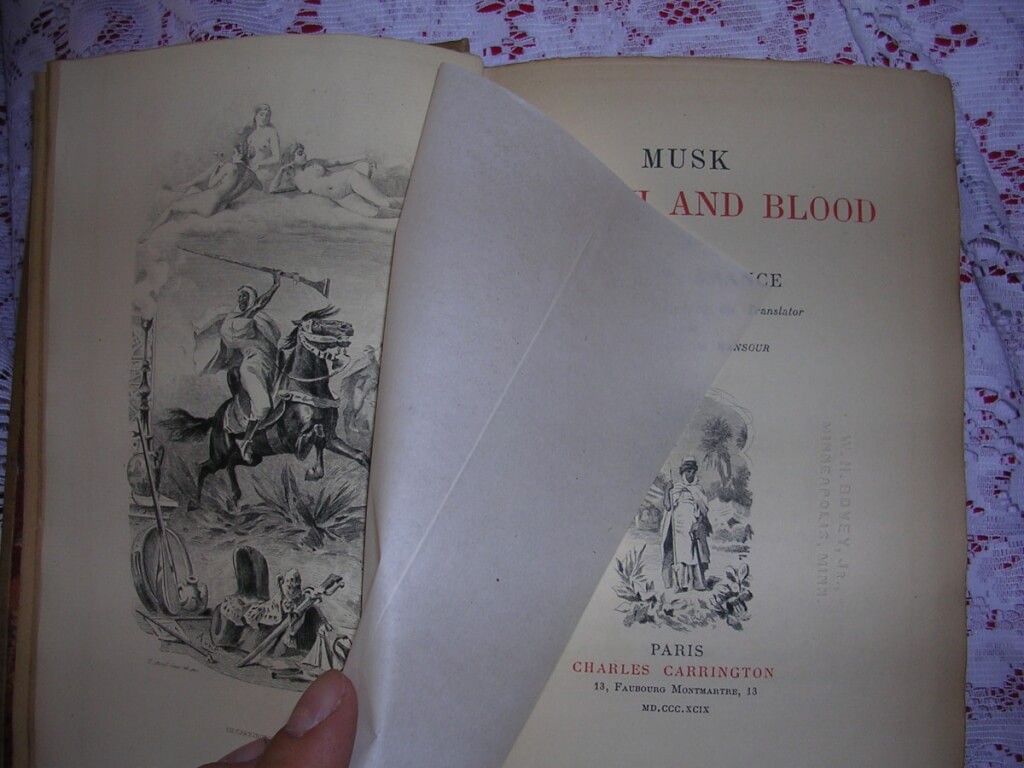 Musk, Hashish and Blood, Hector France, illust. Paul Avril, [trans. most likely Alfred Richard Allinson] (Charles Carrington, Paris, 1899) 8.5" X 5.5", xiii 447pp., hardbound, cloth boards with gilt tittles and decorations. Marbled end papers, deckled edges, frontispiece with tissue guard and numerous illustrations throughout. Good condition, binding is cocked but intact. Owner's signature in front, ink stamp in back, and imprint on title page reads "W.H. Bovey, Minneapolis, MN." Hector France (1837 - 1908) was a French author best known for his "orientalist" and flagellation tales. This graphic and exciting picture of the Algerian desert, its tribes and their astounding customs is a sensational recounting of France's experiences in North Africa. France tells the stories of his adventures in the nineteenth century Arab world from an eyewitness view. "The adventures of a modern man among the cruel men and passionate women of Algiers." Édouard-Henri Avril (1849-1928) used the pseudonym "Paul Avril" for his erotic work. He was a French painter and commercial artist. His career saw collaboration with influential people like Octave Uzanne, Henry Spencer Ashbee and Friedrich Karl Forberg. He is one of the most celebrated erotic artists of his age. Avril was a soldier before starting his career in art. He was awarded with the Legion of Honour for his actions in the Franco-Prussian War.
Musk, Hashish and Blood, Hector France, illust. Paul Avril, [trans. most likely Alfred Richard Allinson] (Charles Carrington, Paris, 1899) 8.5" X 5.5", xiii 447pp., hardbound, cloth boards with gilt tittles and decorations. Marbled end papers, deckled edges, frontispiece with tissue guard and numerous illustrations throughout. Good condition, binding is cocked but intact. Owner's signature in front, ink stamp in back, and imprint on title page reads "W.H. Bovey, Minneapolis, MN." Hector France (1837 - 1908) was a French author best known for his "orientalist" and flagellation tales. This graphic and exciting picture of the Algerian desert, its tribes and their astounding customs is a sensational recounting of France's experiences in North Africa. France tells the stories of his adventures in the nineteenth century Arab world from an eyewitness view. "The adventures of a modern man among the cruel men and passionate women of Algiers." Édouard-Henri Avril (1849-1928) used the pseudonym "Paul Avril" for his erotic work. He was a French painter and commercial artist. His career saw collaboration with influential people like Octave Uzanne, Henry Spencer Ashbee and Friedrich Karl Forberg. He is one of the most celebrated erotic artists of his age. Avril was a soldier before starting his career in art. He was awarded with the Legion of Honour for his actions in the Franco-Prussian War. -
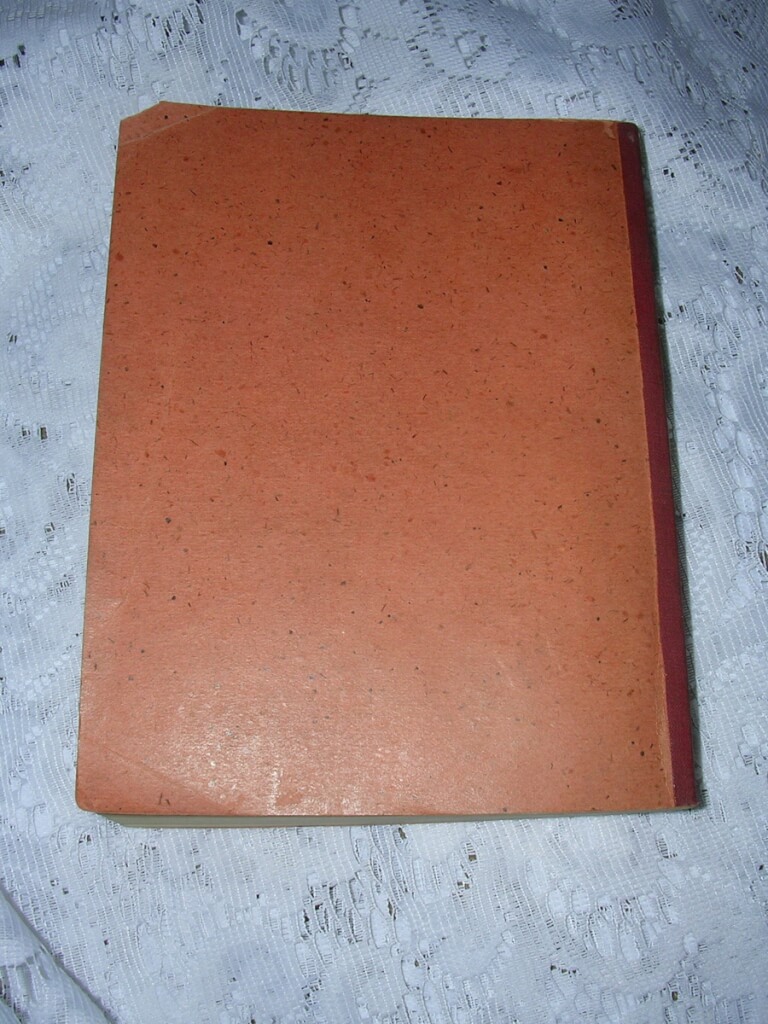
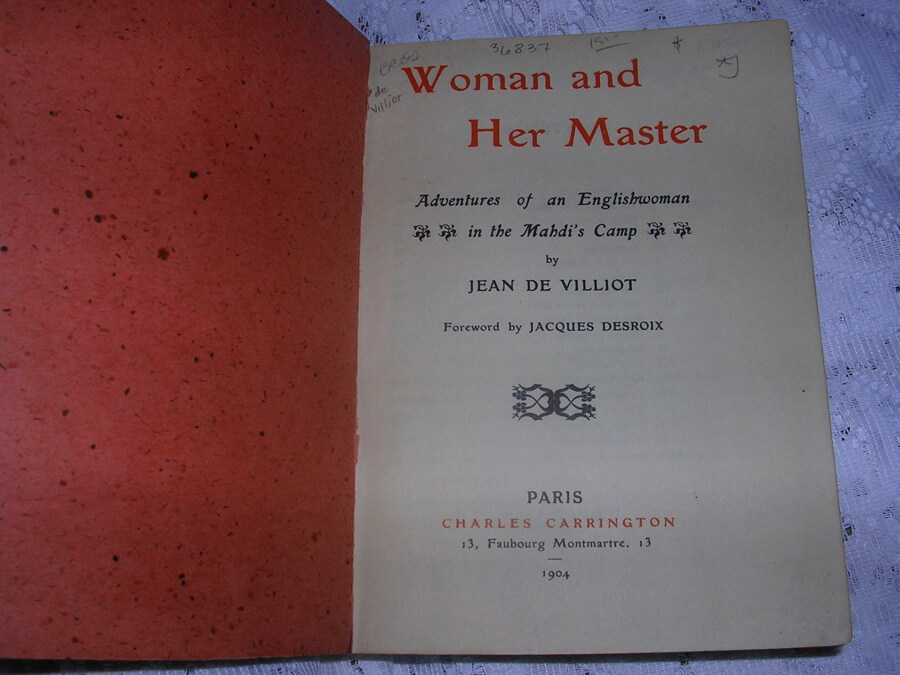 Jean de Villiot [George Grassal (Hugues Rebell)] (Charles Carrington, Paris, 1904 [printed "Alençon, Imprimerie Veuve Félix Guy et Cie"]) 6 3/8" X 5", 301pp, soft bound, red cloth spine with titling to paper label, orange paper covers, good condition, crease in lower corner of cover and inch tear along gutter's edge, slightly yellow pages
Jean de Villiot [George Grassal (Hugues Rebell)] (Charles Carrington, Paris, 1904 [printed "Alençon, Imprimerie Veuve Félix Guy et Cie"]) 6 3/8" X 5", 301pp, soft bound, red cloth spine with titling to paper label, orange paper covers, good condition, crease in lower corner of cover and inch tear along gutter's edge, slightly yellow pages -

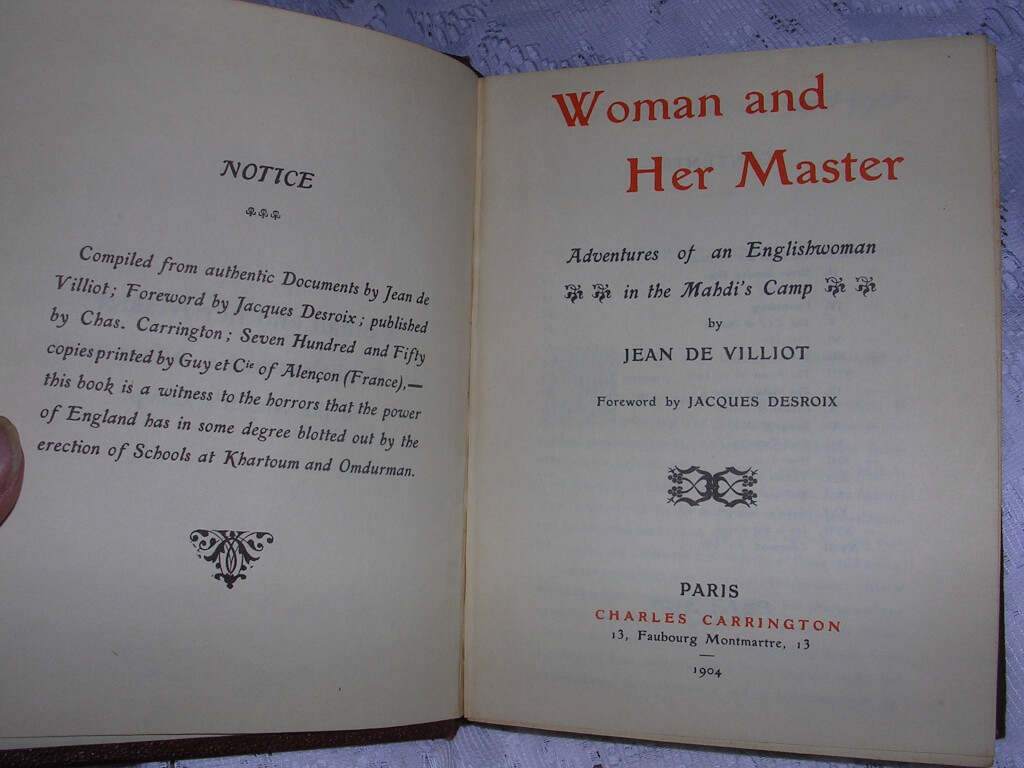 Woman and her Master; an Englishwoman's Adventures in the Madhi's Camp, Jean de Villiot [George Grassal (Hugues Rebell)] (Charles Carrington, Paris, 1904 [printed "Alençon, Imprimerie Veuve Félix Guy et Cie"] stated limited edition 750 copies) 6 3/8" X 5", 301pp, hardbound, red pebbled cloth boards, gilt title on front, no writing on spine, sewn signatures, good condition, some minor bumping and rubbing Jean de Villiot was a pseudonym used by several authors and compilers working for the publisher Charles Carrington writing novels and "studies" concerning flagellation, including Hugues Rebell (Georges Grassal), Hector France, Stéphane Arnoulin and Charles Carrington, himself. This novel is attributed to George Grassal (Hugues Rebell) originally written in French, in 1902, as "La Femme et son maître" (The Woman and her Master). In 1904 "Woman and her Master" was published in English by Charles Carrington. Often these editions were printed unbound and sent to the bookseller to bind to the specifications of their customers. "this book is a witness to the horrors that the power of England has in some degree blotted out by the erection of Schools at Khartoum and Omdurman."
Woman and her Master; an Englishwoman's Adventures in the Madhi's Camp, Jean de Villiot [George Grassal (Hugues Rebell)] (Charles Carrington, Paris, 1904 [printed "Alençon, Imprimerie Veuve Félix Guy et Cie"] stated limited edition 750 copies) 6 3/8" X 5", 301pp, hardbound, red pebbled cloth boards, gilt title on front, no writing on spine, sewn signatures, good condition, some minor bumping and rubbing Jean de Villiot was a pseudonym used by several authors and compilers working for the publisher Charles Carrington writing novels and "studies" concerning flagellation, including Hugues Rebell (Georges Grassal), Hector France, Stéphane Arnoulin and Charles Carrington, himself. This novel is attributed to George Grassal (Hugues Rebell) originally written in French, in 1902, as "La Femme et son maître" (The Woman and her Master). In 1904 "Woman and her Master" was published in English by Charles Carrington. Often these editions were printed unbound and sent to the bookseller to bind to the specifications of their customers. "this book is a witness to the horrors that the power of England has in some degree blotted out by the erection of Schools at Khartoum and Omdurman." -
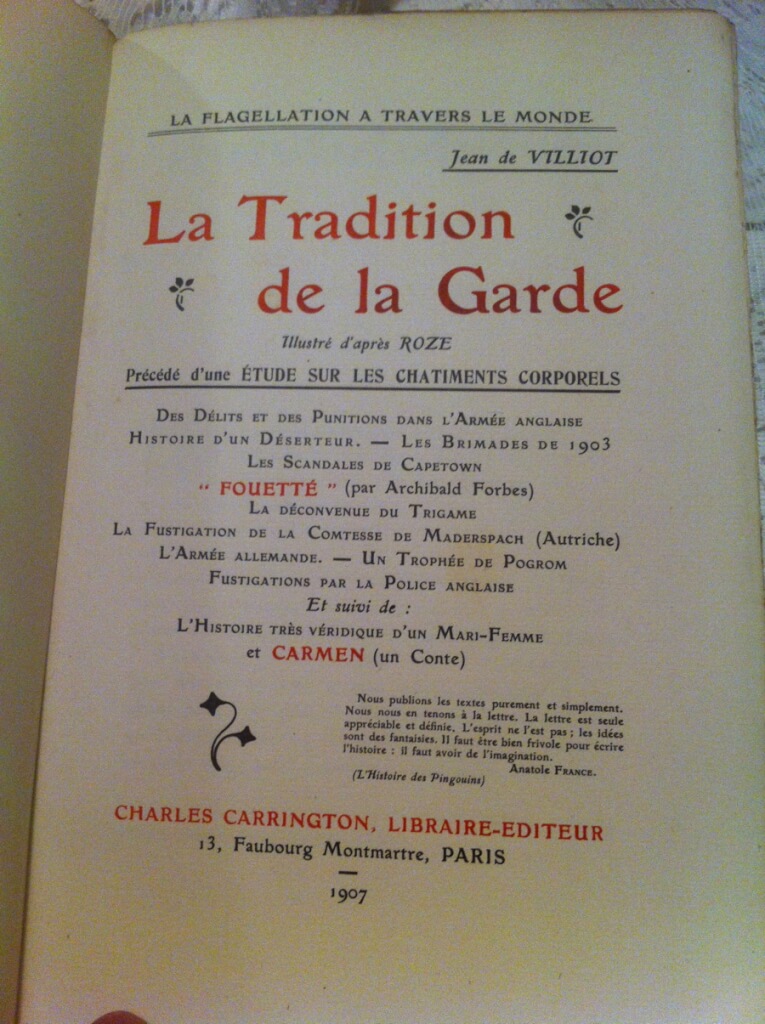
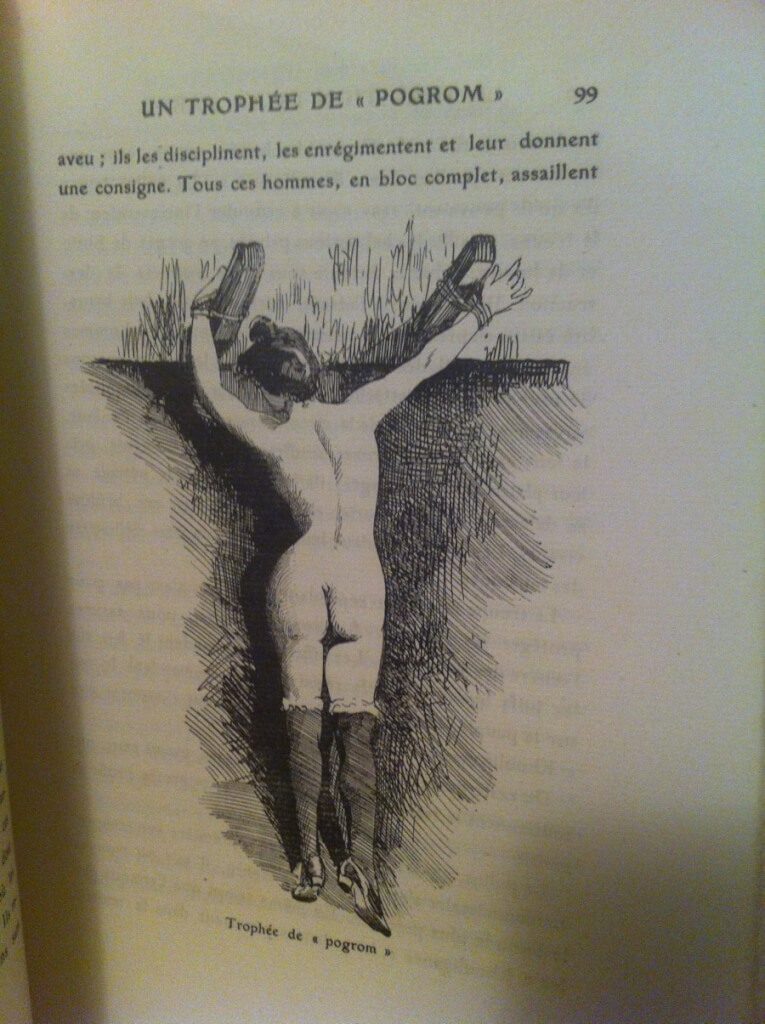 La Tradition de la Garde. Illustré d'après Roze. Précédé d'une étude sur les chatiments corporels. [Tradition of the Guard. Illustrated by Roze. Preceded by a study on corporal punishment.] by Jean de Villiot, [pseud. Georges Grassal de Choffat or Hugues Rebell], illus. Léon Roze (Charles Carrington, Paris, 1907, #244/700) 7.75" x 9.75", 209pp, very good condition for age, some light stains, soft covers and binding good, a rare, numerous illustrations
La Tradition de la Garde. Illustré d'après Roze. Précédé d'une étude sur les chatiments corporels. [Tradition of the Guard. Illustrated by Roze. Preceded by a study on corporal punishment.] by Jean de Villiot, [pseud. Georges Grassal de Choffat or Hugues Rebell], illus. Léon Roze (Charles Carrington, Paris, 1907, #244/700) 7.75" x 9.75", 209pp, very good condition for age, some light stains, soft covers and binding good, a rare, numerous illustrations -
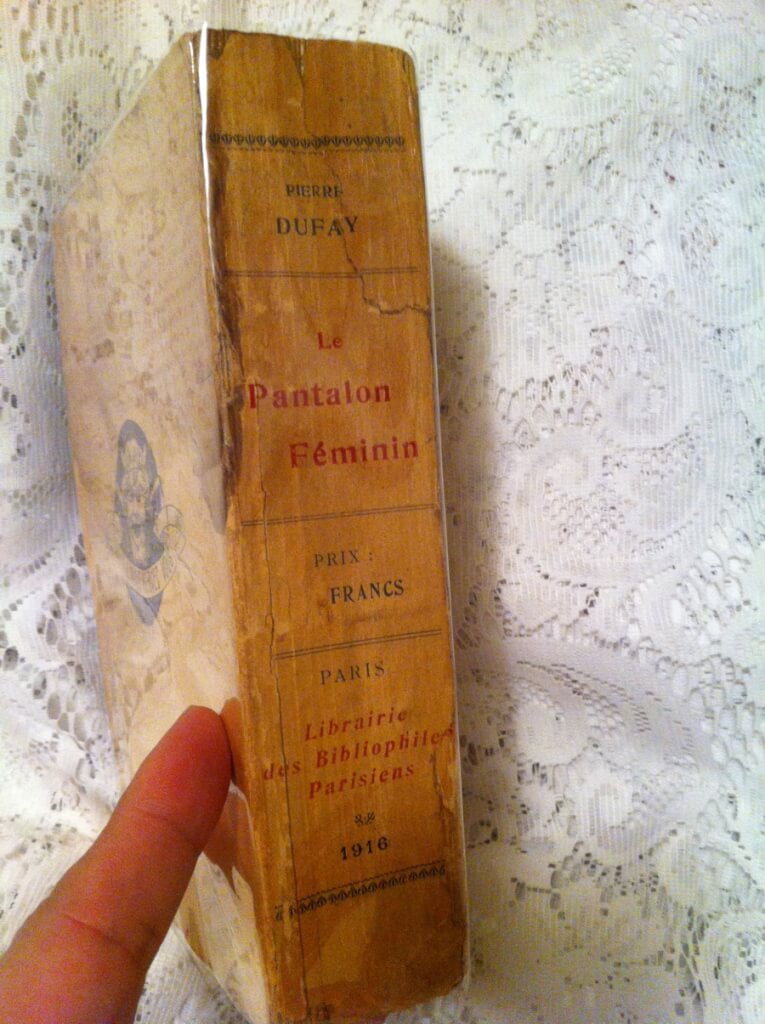
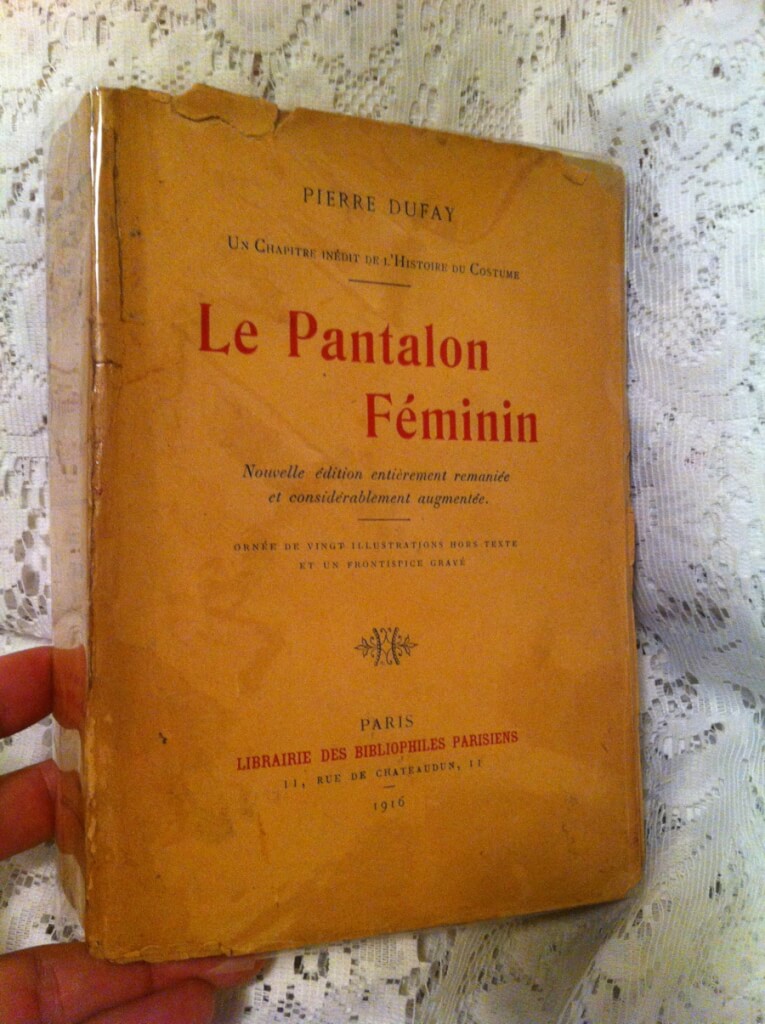 Le Pantalon Féminin (Un chapitre inédit de l'Histoire du Costume) by Pierre Dufay, preface by d'Armand Silvestre (Charles Carrington, Librairie Des Bibliophiles Parisiens, 1916, Paris) 7.75" X 5.75", xv 584pp., original soft wraps protected by a clear archival dust cover. Deckled edges. Some pages remain uncut. Index, table of contents, errata, and 5 pages of ads in the back. Good condition for age, some tears to the edges of cover, stain on the back. A rare find with it's illustrations intact.
Le Pantalon Féminin (Un chapitre inédit de l'Histoire du Costume) by Pierre Dufay, preface by d'Armand Silvestre (Charles Carrington, Librairie Des Bibliophiles Parisiens, 1916, Paris) 7.75" X 5.75", xv 584pp., original soft wraps protected by a clear archival dust cover. Deckled edges. Some pages remain uncut. Index, table of contents, errata, and 5 pages of ads in the back. Good condition for age, some tears to the edges of cover, stain on the back. A rare find with it's illustrations intact. -

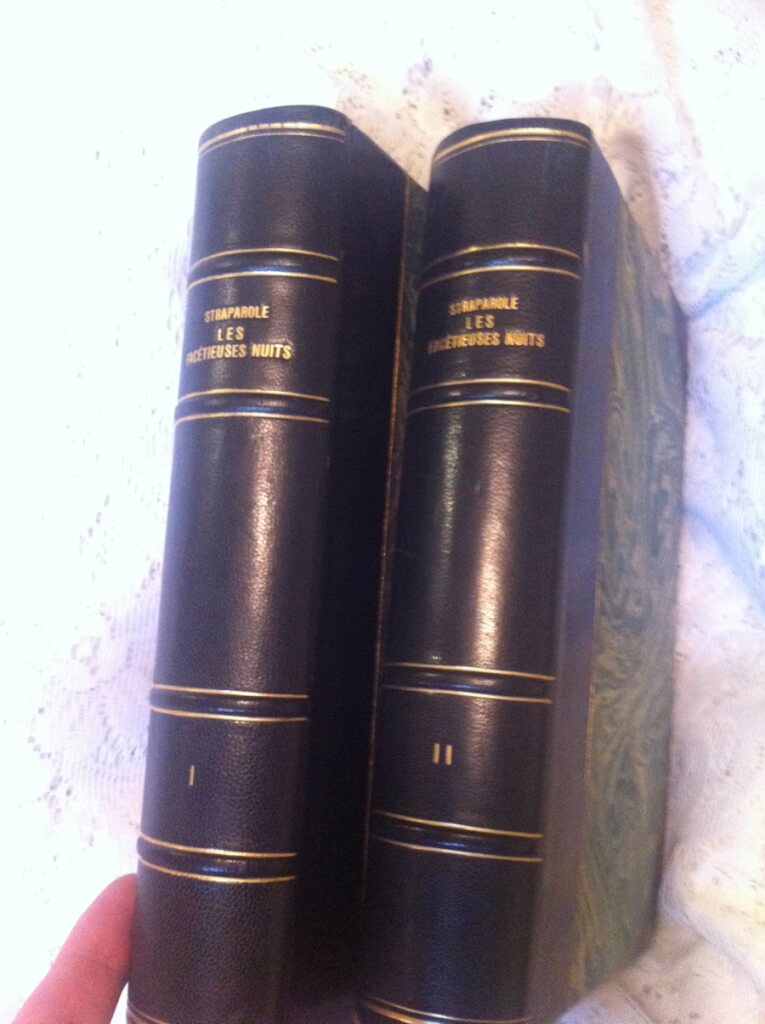 Les Facetieuses Nuits de Straparole, Giovanni Francesco Straparola, trans. Jean Louveau, illus. L_on Lebègue. Preface by Jules de Marthold (Charles Carrington, Paris, 1907 #213/800) 9.5" x 6.25", 2 vol. lxxxvii+312pp. vi+371pp. 1/2 leather over marbled boards, 4 raised bands on spine gilt lettering and decorations, marbled endpapers, gilted top-edge, others deckled, many color illustrations protected by tissues with descrptions printed on them, text decorations throughout, near fine condition, book binder tag for "Hans Uttinger, Buchbinderei, Einrahmungsgeschäft, Luzern" The Facetious Nights of Straparola (1550-1555; Italian: Le piacevoli notti), also known as The Nights of Straparola, is a two-volume collection of 75 stories by Italian author and fairy-tale collector Giovanni Francesco Straparola(c.1480-c.1557). Modeled after Bocaccio's Decameron, it has participants of a 13-night party in the island of Murano, near Venice, tell each other stories that vary from bawdy to fantastic. It contains the first known written versions of many fairy tales. It would influence later fairy-tale authors like Charles Perrault and Jacob and Wilhelm Grimm. This book is a very rare and famous (and famously illustrated) edition. A beautiful copy of a beautifully made book.
Les Facetieuses Nuits de Straparole, Giovanni Francesco Straparola, trans. Jean Louveau, illus. L_on Lebègue. Preface by Jules de Marthold (Charles Carrington, Paris, 1907 #213/800) 9.5" x 6.25", 2 vol. lxxxvii+312pp. vi+371pp. 1/2 leather over marbled boards, 4 raised bands on spine gilt lettering and decorations, marbled endpapers, gilted top-edge, others deckled, many color illustrations protected by tissues with descrptions printed on them, text decorations throughout, near fine condition, book binder tag for "Hans Uttinger, Buchbinderei, Einrahmungsgeschäft, Luzern" The Facetious Nights of Straparola (1550-1555; Italian: Le piacevoli notti), also known as The Nights of Straparola, is a two-volume collection of 75 stories by Italian author and fairy-tale collector Giovanni Francesco Straparola(c.1480-c.1557). Modeled after Bocaccio's Decameron, it has participants of a 13-night party in the island of Murano, near Venice, tell each other stories that vary from bawdy to fantastic. It contains the first known written versions of many fairy tales. It would influence later fairy-tale authors like Charles Perrault and Jacob and Wilhelm Grimm. This book is a very rare and famous (and famously illustrated) edition. A beautiful copy of a beautifully made book. -
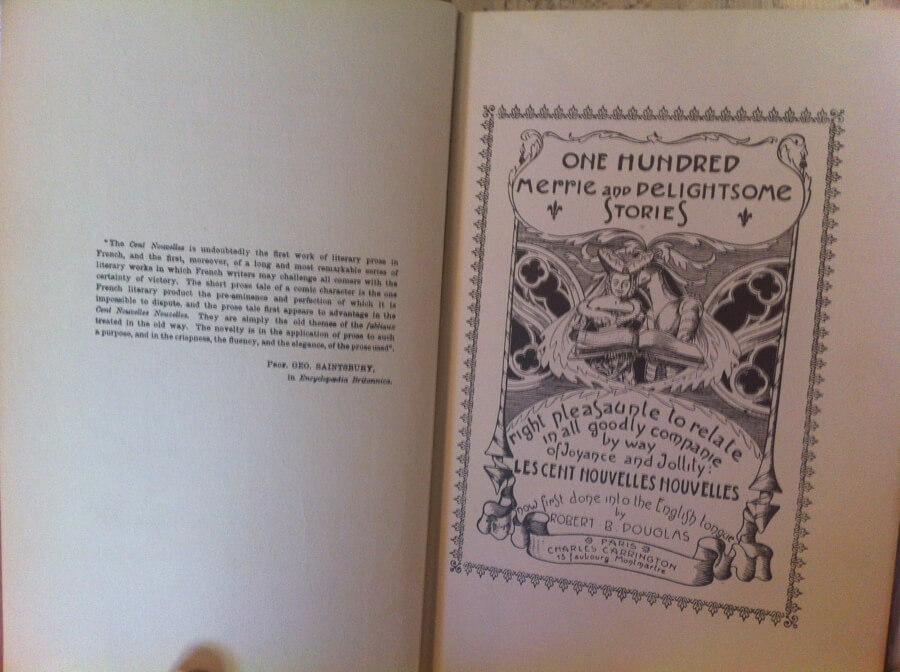
 One Hundred Merrie and Delightsome Stories, ed. by Antoine de La Sale, trans. Robert B. Douglas (Charles Carrington, Paris, 1899 [pirated facimile reprint, probably New York, c.1930 states "privately printed from the Charles Carrington Paris 1899 edition] #294/1250) 8" X 5.75", two volumes, xxx+532pp, pagination continuous. Fifty-two b&w plates by Léon Lebègue, marbled boards, gilt on spine, top edge gilt, other edges deckled, very good condition, minor bumping, some stains on front cover of vol. 2 Charles Carrington was the first to have this translated into English. This is a pirated copy, but still very nicely printed on good paper, the illustrations are in B&W. Purported a collection of short stories narrated by various persons at the court of Philippe le Bon, and collected together by Antoine de la Sale, the nouvelles are, according to the authority on French Literature—Professor George Saintsbury "undoubtedly the first work of literary prose in French ... The short prose tale of a comic character is the one French literary product the pre-eminence and perfection of which it is impossible to dispute, and the prose tale first appears to advantage in the Cent Nouvelles Nouvelles." The stories give a curious glimpses of life in the 15th century, providing a genuine view of the social condition of the nobility and the middle classes. M. Lenient, a French critic, says: "Generally the incidents and personages belong to the bourgeoisée; there is nothing chivalric, nothing wonderful; no dreamy lovers, romantic dames, fairies, or enchanters. Noble dames, bourgeois, nuns, knights, merchants, monks, and peasants mutually dupe each other. The lord deceives the miller's wife by imposing on her simplicity, and the miller retaliates in much the same manner. The shepherd marries the knight's sister, and the nobleman is not over scandalized. The vices of the monks are depicted in half a score tales, and the seducers are punished with a severity not always in proportion to the offence." For four centuries 10 of the stories were credited to Louis XI. Modern scholars have since ascribed them to either Philippe le Bel or Comte de Charolais. In all, some thirty-two noblemen or squires contributed the stories, with some 14 or 15 taken from Giovanni Boccaccio, and as many more from Gian Francesco Poggio Bracciolini or other Italian writers, or French fabliaux, but about 70 of them appear to be original.
One Hundred Merrie and Delightsome Stories, ed. by Antoine de La Sale, trans. Robert B. Douglas (Charles Carrington, Paris, 1899 [pirated facimile reprint, probably New York, c.1930 states "privately printed from the Charles Carrington Paris 1899 edition] #294/1250) 8" X 5.75", two volumes, xxx+532pp, pagination continuous. Fifty-two b&w plates by Léon Lebègue, marbled boards, gilt on spine, top edge gilt, other edges deckled, very good condition, minor bumping, some stains on front cover of vol. 2 Charles Carrington was the first to have this translated into English. This is a pirated copy, but still very nicely printed on good paper, the illustrations are in B&W. Purported a collection of short stories narrated by various persons at the court of Philippe le Bon, and collected together by Antoine de la Sale, the nouvelles are, according to the authority on French Literature—Professor George Saintsbury "undoubtedly the first work of literary prose in French ... The short prose tale of a comic character is the one French literary product the pre-eminence and perfection of which it is impossible to dispute, and the prose tale first appears to advantage in the Cent Nouvelles Nouvelles." The stories give a curious glimpses of life in the 15th century, providing a genuine view of the social condition of the nobility and the middle classes. M. Lenient, a French critic, says: "Generally the incidents and personages belong to the bourgeoisée; there is nothing chivalric, nothing wonderful; no dreamy lovers, romantic dames, fairies, or enchanters. Noble dames, bourgeois, nuns, knights, merchants, monks, and peasants mutually dupe each other. The lord deceives the miller's wife by imposing on her simplicity, and the miller retaliates in much the same manner. The shepherd marries the knight's sister, and the nobleman is not over scandalized. The vices of the monks are depicted in half a score tales, and the seducers are punished with a severity not always in proportion to the offence." For four centuries 10 of the stories were credited to Louis XI. Modern scholars have since ascribed them to either Philippe le Bel or Comte de Charolais. In all, some thirty-two noblemen or squires contributed the stories, with some 14 or 15 taken from Giovanni Boccaccio, and as many more from Gian Francesco Poggio Bracciolini or other Italian writers, or French fabliaux, but about 70 of them appear to be original. -
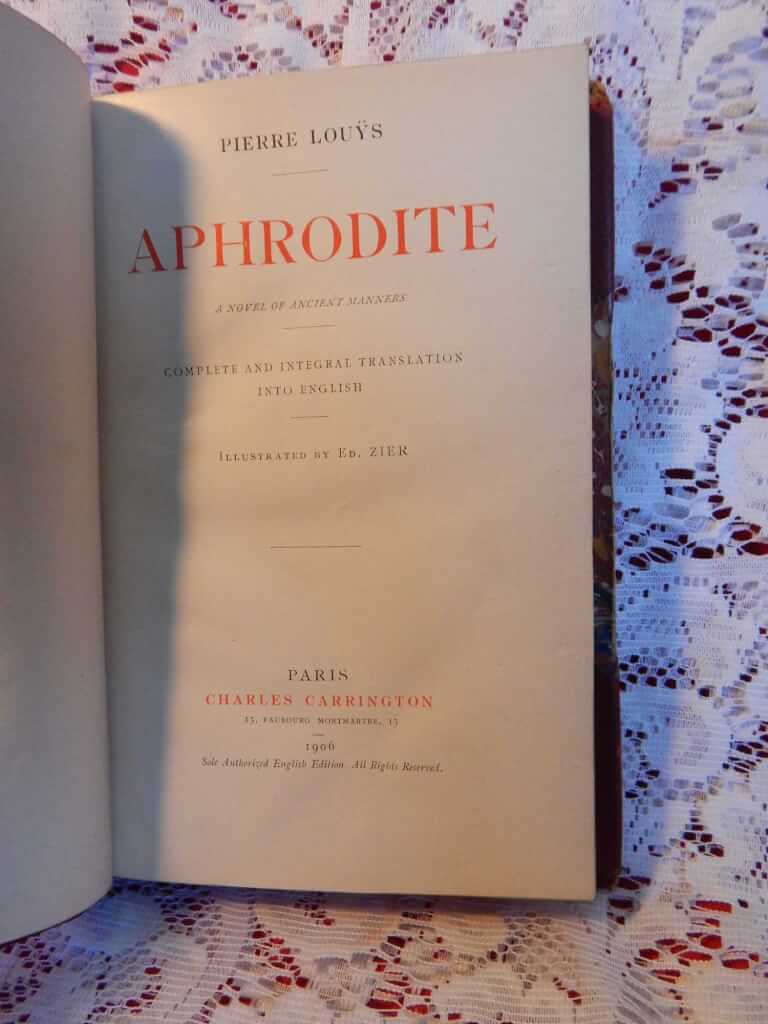
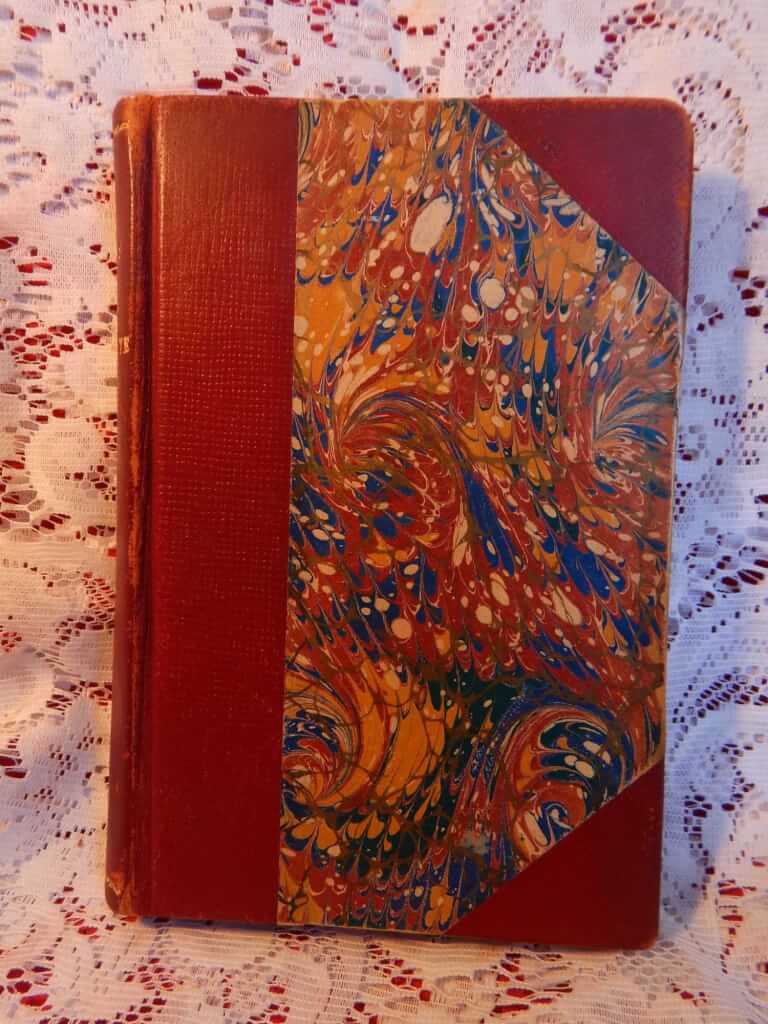 Aphrodite, a novel of ancient manners, by Pierre Louÿs, illus. Ed. Zier (Charles Carrington, 1906, first edition thus, first English translation) 5.25 x 8", 412pp, marbled boards with three quarter red cloth, gilt lettering and decoration on spine, very good condition for age, some slight bumping/scuffing Pierre Louys (1870 - 1925) was a French poet and writer, most renowned for lesbian and classical themes in some of his writings. He is known as a writer who "expressed pagan sensuality with stylistic perfection." "Aphrodite: mæurs antiques" (Ancient Manners) is a "libertine" story set in ancient Alexandria. Highlights include the loves of Chrysis, an orgy banquet ending in the crucifixion of a slave, the love of two young musician girls and the festivals of Aphrodite. "This Translation of Aphrodite was executed on the Printing Presses of Charles Herissey, at Evreux (France), for Mr. Charles Carrington, Paris, Bookseller et Publisher, and is the only complete English version extant." Édouard François Zier, (1856-1924) was a French illustrator and painter.
Aphrodite, a novel of ancient manners, by Pierre Louÿs, illus. Ed. Zier (Charles Carrington, 1906, first edition thus, first English translation) 5.25 x 8", 412pp, marbled boards with three quarter red cloth, gilt lettering and decoration on spine, very good condition for age, some slight bumping/scuffing Pierre Louys (1870 - 1925) was a French poet and writer, most renowned for lesbian and classical themes in some of his writings. He is known as a writer who "expressed pagan sensuality with stylistic perfection." "Aphrodite: mæurs antiques" (Ancient Manners) is a "libertine" story set in ancient Alexandria. Highlights include the loves of Chrysis, an orgy banquet ending in the crucifixion of a slave, the love of two young musician girls and the festivals of Aphrodite. "This Translation of Aphrodite was executed on the Printing Presses of Charles Herissey, at Evreux (France), for Mr. Charles Carrington, Paris, Bookseller et Publisher, and is the only complete English version extant." Édouard François Zier, (1856-1924) was a French illustrator and painter. -

 Les métamorphoses ou l'asne d'or de Luce Apulée philosophe platonique, Lucius Apuleius Madaurensis (124-170 AD), trans. Jules De Marthold, illust. [21 etchings] Martin van Maele (Charles Carrington, Librairie-Éditeur, 1905, Paris, #88/750) 9.25" X 6.25", xlviii+328pp., original soft wraps protected by glassine wraps, Chapter pieces in orange and black, tail pieces in black, large, decorative first letter of each chapter, frontispiece + 21 full-page b/w engravings with tissue guards and numerous in-text illustrations by Martin van Maele, very good condition for age. The Metamorphoses of Apuleius, which St. Augustine referred to as "The Golden Ass", is the only Ancient Roman novel in Latin to survive in its entirety. The plot Lucius and his curiosity and insatiable desire to see and practice magic. While trying to perform a spell to transform into a bird, he is accidentally transformed into an ass. This leads to a long journey, literal and metaphorical, filled with in-set tales. He finally finds salvation through the intervention of the goddess Isis, whose cult he joins. The date of the original work is uncertain. Scholars are not sure if he wrote it in his youth or at the end of his life. He adapted the story from a Greek story written by Lucius of Patrae, however his original Greek text has long been lost. Maurice François Alfred Martin van Miële (1863-5 - 1926), better known by his pseudonym Martin van Maële, was a French illustrator of early 20th century literature. Though he gained notoriety with his illustration for H. G. Wells in Les Premiers Hommes dans la Lune, and he worked as an illustrator for the Félix Juven's French translations of the Sherlock Holmes series, he is now most widely renowned and mostly remembered for his erotic illustrations. This is a beautiful and rare book in it's original paper wraps.
Les métamorphoses ou l'asne d'or de Luce Apulée philosophe platonique, Lucius Apuleius Madaurensis (124-170 AD), trans. Jules De Marthold, illust. [21 etchings] Martin van Maele (Charles Carrington, Librairie-Éditeur, 1905, Paris, #88/750) 9.25" X 6.25", xlviii+328pp., original soft wraps protected by glassine wraps, Chapter pieces in orange and black, tail pieces in black, large, decorative first letter of each chapter, frontispiece + 21 full-page b/w engravings with tissue guards and numerous in-text illustrations by Martin van Maele, very good condition for age. The Metamorphoses of Apuleius, which St. Augustine referred to as "The Golden Ass", is the only Ancient Roman novel in Latin to survive in its entirety. The plot Lucius and his curiosity and insatiable desire to see and practice magic. While trying to perform a spell to transform into a bird, he is accidentally transformed into an ass. This leads to a long journey, literal and metaphorical, filled with in-set tales. He finally finds salvation through the intervention of the goddess Isis, whose cult he joins. The date of the original work is uncertain. Scholars are not sure if he wrote it in his youth or at the end of his life. He adapted the story from a Greek story written by Lucius of Patrae, however his original Greek text has long been lost. Maurice François Alfred Martin van Miële (1863-5 - 1926), better known by his pseudonym Martin van Maële, was a French illustrator of early 20th century literature. Though he gained notoriety with his illustration for H. G. Wells in Les Premiers Hommes dans la Lune, and he worked as an illustrator for the Félix Juven's French translations of the Sherlock Holmes series, he is now most widely renowned and mostly remembered for his erotic illustrations. This is a beautiful and rare book in it's original paper wraps. -
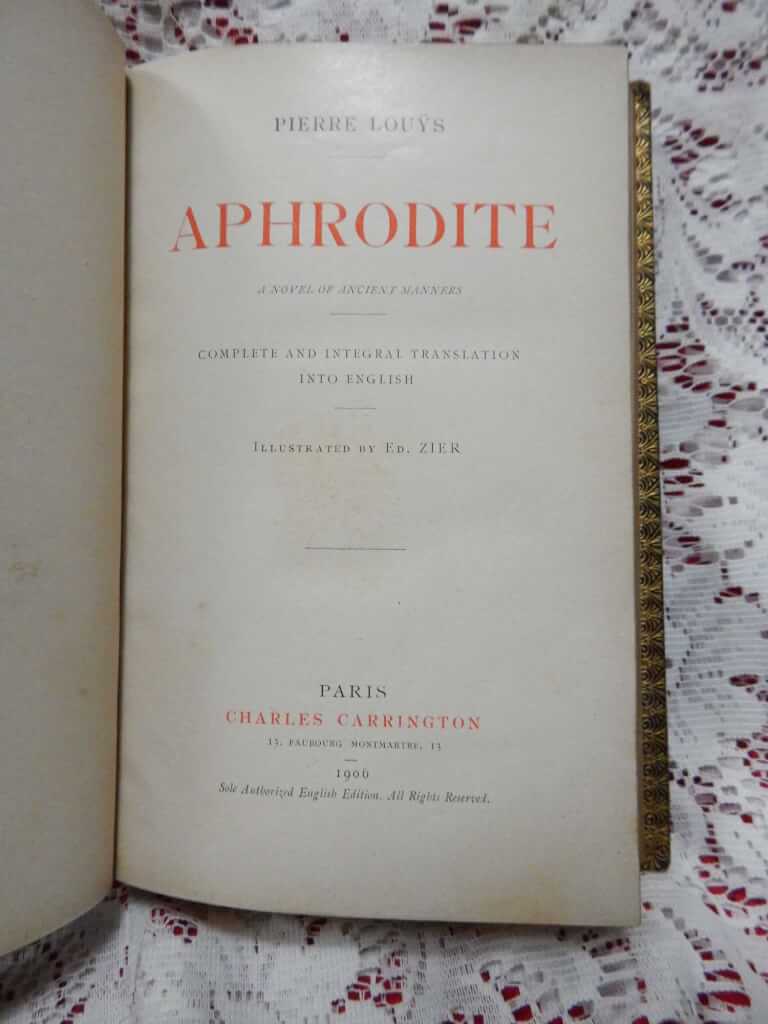
 Aphrodite, a novel of ancient manners, by Pierre Louÿs, illus. Ed. Zier (Charles Carrington, 1906, first edition thus, first English translation) 5.25 x 8", 412pp, full green moroccan, gilt lettering and decoration on spine and borders, 5 raised bands, gilt edges, gilt decorations boardering pastedown, near fine condition, some cracks in the hinges. Pierre Louys (1870 - 1925) was a French poet and writer, most renowned for lesbian and classical themes in some of his writings. He is known as a writer who "expressed pagan sensuality with stylistic perfection." "Aphrodite: mæurs antiques" (Ancient Manners) is a "libertine" story set in ancient Alexandria. Highlights include the loves of Chrysis, an orgy banquet ending in the crucifixion of a slave, the love of two young musician girls and the festivals of Aphrodite. "This Translation of Aphrodite was executed on the Printing Presses of Charles Herissey, at Evreux (France), for Mr. Charles Carrington, Paris, Bookseller et Publisher, and is the only complete English version extant." A beautiful example of this important first edition of the first translation. Very hard to find in full leather. Édouard François Zier (1856-1924) was a French illustrator and painter.
Aphrodite, a novel of ancient manners, by Pierre Louÿs, illus. Ed. Zier (Charles Carrington, 1906, first edition thus, first English translation) 5.25 x 8", 412pp, full green moroccan, gilt lettering and decoration on spine and borders, 5 raised bands, gilt edges, gilt decorations boardering pastedown, near fine condition, some cracks in the hinges. Pierre Louys (1870 - 1925) was a French poet and writer, most renowned for lesbian and classical themes in some of his writings. He is known as a writer who "expressed pagan sensuality with stylistic perfection." "Aphrodite: mæurs antiques" (Ancient Manners) is a "libertine" story set in ancient Alexandria. Highlights include the loves of Chrysis, an orgy banquet ending in the crucifixion of a slave, the love of two young musician girls and the festivals of Aphrodite. "This Translation of Aphrodite was executed on the Printing Presses of Charles Herissey, at Evreux (France), for Mr. Charles Carrington, Paris, Bookseller et Publisher, and is the only complete English version extant." A beautiful example of this important first edition of the first translation. Very hard to find in full leather. Édouard François Zier (1856-1924) was a French illustrator and painter. -
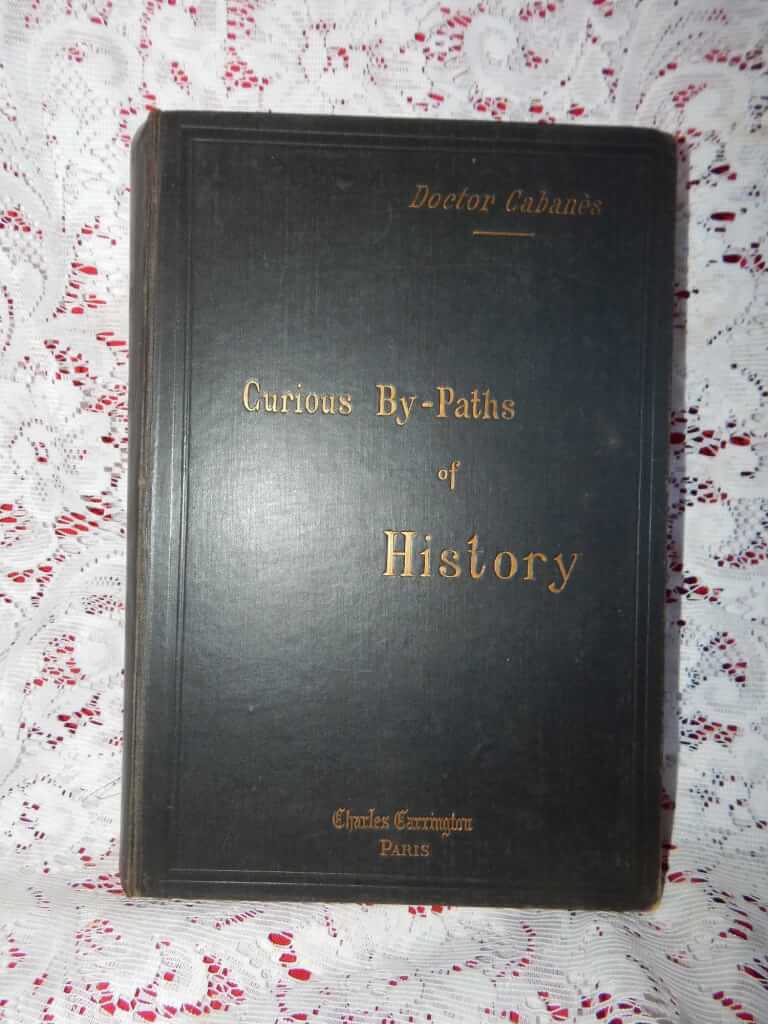
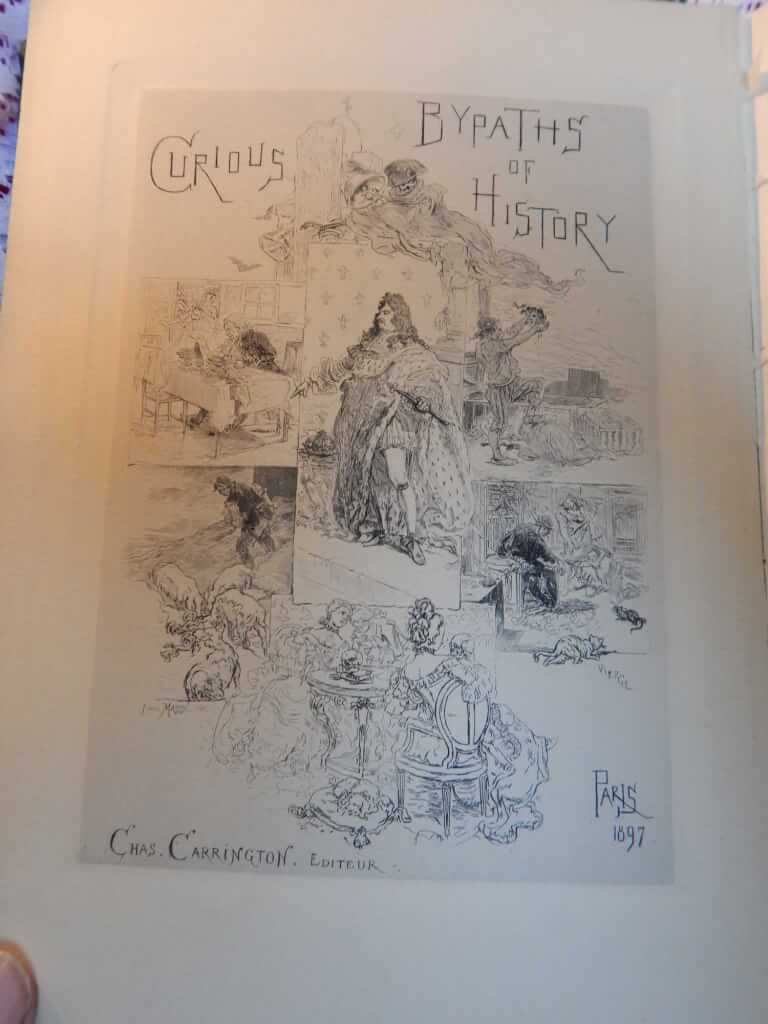 Curious Bypaths of History: Being Medico-Historical Studies and Observations, by Dr. [Augustin] Cabanès, frontispiece by Daniel Vierge engraved on copper by F. Massé (Librairie Des Bibliophiles, Charles Carrington, Éditeur, Paris 1898, #238/500) 7"x10", xx+367pp, black cloth with gilt titles on cover and spine (spine titles faded), front boards loose but holding, marbled endpapers, printed on "Van Gelder's vellum paper", gilt top edge, other edges deckled. Charles Carrington published a series of 3 books looking into the private lives of the French aristocracy titled, "Pathological studies of the past". The books are Secret Cabinet of History Peeped into By a Doctor (1897), Curious Bypaths of History: Being Medico-Historical Studies and Observations (1898), Flagellation in France from a medical and historical standpoint (1898). The first two and possibly the third were written by Dr. Augustin Cabanès (1862-1928), a French doctor, historian and author. Contents of this book, Curious Bypaths of History, include: The Teeth of Louis Xi, The Clandestine Accouchements of Mdlle De La Valliere (Louise de La Vallière was a mistress of Louis XIV of France from 1661 to 1667.), Illustrious Remains And Anatomical Relics. — the Skeleton of Mme De Maintenon And the Skull of Mme De Sevigne, The Infirmities of Sophie Arnould (a very popular French operatic soprano), Was Dr. Guillotin the Inventor Or the God-Father, of the Guillotine?, the Real Charlotte Corday. — Her Personal Appearance (Marie-Anne Charlotte de Corday d'Armont was a figure of the French Revolution. In 1793, she was executed by guillotine for the assassination of Jacobin leader Jean-Paul Marat, who was in part responsible for the more radical course the Revolution had taken through his role as a politician and journalist.), The Superstitions of Napoleon I, A Romance With Three Actors: Alfred De Musset, George Sand, And Doctor Pagello.
Curious Bypaths of History: Being Medico-Historical Studies and Observations, by Dr. [Augustin] Cabanès, frontispiece by Daniel Vierge engraved on copper by F. Massé (Librairie Des Bibliophiles, Charles Carrington, Éditeur, Paris 1898, #238/500) 7"x10", xx+367pp, black cloth with gilt titles on cover and spine (spine titles faded), front boards loose but holding, marbled endpapers, printed on "Van Gelder's vellum paper", gilt top edge, other edges deckled. Charles Carrington published a series of 3 books looking into the private lives of the French aristocracy titled, "Pathological studies of the past". The books are Secret Cabinet of History Peeped into By a Doctor (1897), Curious Bypaths of History: Being Medico-Historical Studies and Observations (1898), Flagellation in France from a medical and historical standpoint (1898). The first two and possibly the third were written by Dr. Augustin Cabanès (1862-1928), a French doctor, historian and author. Contents of this book, Curious Bypaths of History, include: The Teeth of Louis Xi, The Clandestine Accouchements of Mdlle De La Valliere (Louise de La Vallière was a mistress of Louis XIV of France from 1661 to 1667.), Illustrious Remains And Anatomical Relics. — the Skeleton of Mme De Maintenon And the Skull of Mme De Sevigne, The Infirmities of Sophie Arnould (a very popular French operatic soprano), Was Dr. Guillotin the Inventor Or the God-Father, of the Guillotine?, the Real Charlotte Corday. — Her Personal Appearance (Marie-Anne Charlotte de Corday d'Armont was a figure of the French Revolution. In 1793, she was executed by guillotine for the assassination of Jacobin leader Jean-Paul Marat, who was in part responsible for the more radical course the Revolution had taken through his role as a politician and journalist.), The Superstitions of Napoleon I, A Romance With Three Actors: Alfred De Musset, George Sand, And Doctor Pagello. -
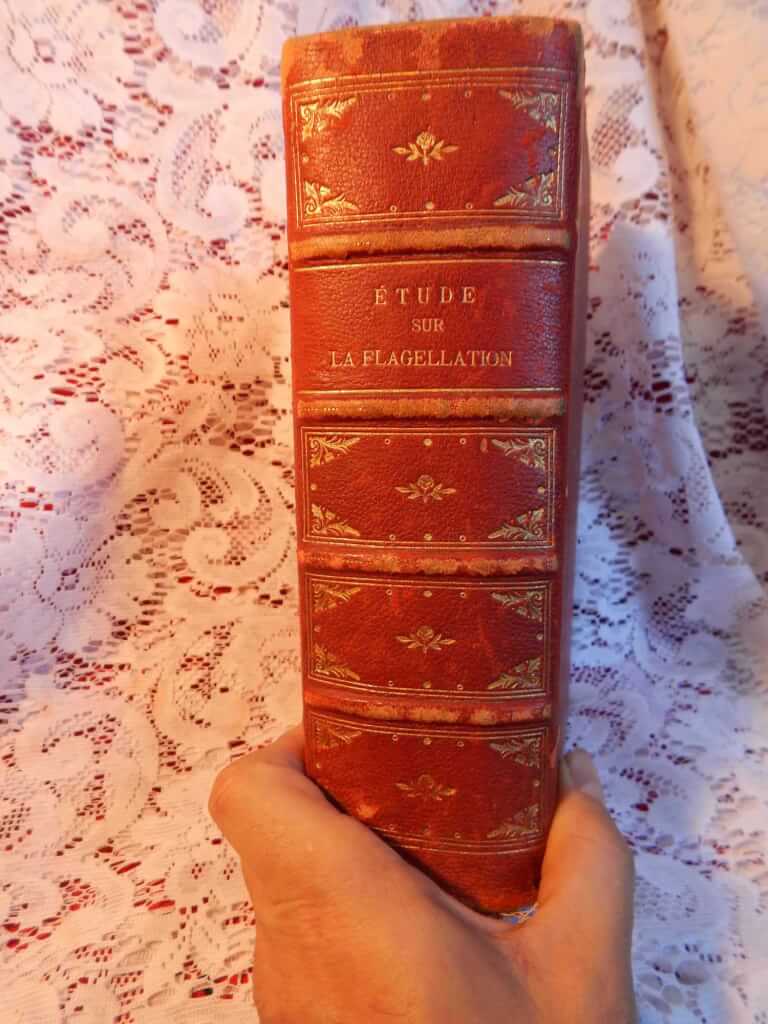
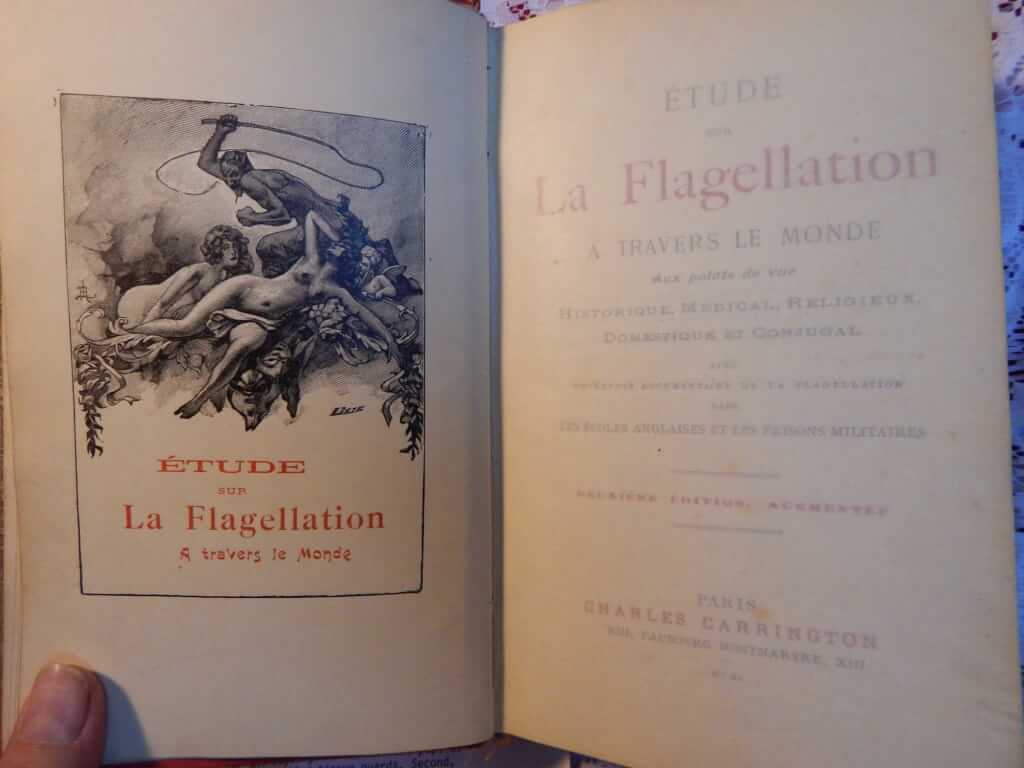 Étude sur La Flagellation a travers le monde aux points de vue Historique, Medical, Religieux, Domestique et Conjugal | avec un exposé documentaire de la flagellation dans Les écoles anglaises et les prisons militaires, Deuxiéme Édition, Augmentée [Study of the Flagellation throughout the world from the historical, medical, religious, domestic and marital points of view | with a documentary presentation of flogging in English Schools and Military Prisons, Second Edition, Augmented], by Jean de Villiot [pseud. most likely of Charles Carrington, Hugues Rebell and Hector France],illust. by René Lelong, (Charles Carrington, Paris, 1901, "Second Edition Augmented", printed by Achevé d'imprimer le 29 septembre 1900 par Em. Pivoteau. Imprimeur à Saint-Amand-Mont-Rond (Cher)) 5.5"x8.5", xxiv+646pp, quarter-bound in red morocco over red boards, 4 raised bands, gilt titles and decorations on spine, marbled paste-downs, all edges gilt, ribbon intact, binding frayed a bit at bottom, some rubbing and stains, otherwise very good condition for age, frontispiece and 20 B&W illustrations by René Lelong tipped in with titled tissue guards. This book is the compilation and expansion of a few other books previously published by Charles Carrington including the original Étude sur La Flagellation a travers le monde published in 1898. It represents a more complete representation of those writings beautifully bound into one book, covering studies on flogging through the centuries, flogging in England, flogging in the history of France (the cases of Madame Du Barry, the Marquise de Rosen.), the flogging from the medical point of view where one learns its healing properties, flogging in literature or the art of using it for pleasure, the discipline to school and domestic and spousal corrections, and "in our current society". Jean de Villiot is a pseudonym frequently used by Carrington and the various authors he relied upon, especially for works that involved flagellation. The illustrator, René Lelong was a third class medalist at the Salon des artistes français of 1895 which he became a member from 1898. He has produced advertising posters and illustrated numerous books and texts. He was a professor at the Julian Academy from 1879 to 1891.
Étude sur La Flagellation a travers le monde aux points de vue Historique, Medical, Religieux, Domestique et Conjugal | avec un exposé documentaire de la flagellation dans Les écoles anglaises et les prisons militaires, Deuxiéme Édition, Augmentée [Study of the Flagellation throughout the world from the historical, medical, religious, domestic and marital points of view | with a documentary presentation of flogging in English Schools and Military Prisons, Second Edition, Augmented], by Jean de Villiot [pseud. most likely of Charles Carrington, Hugues Rebell and Hector France],illust. by René Lelong, (Charles Carrington, Paris, 1901, "Second Edition Augmented", printed by Achevé d'imprimer le 29 septembre 1900 par Em. Pivoteau. Imprimeur à Saint-Amand-Mont-Rond (Cher)) 5.5"x8.5", xxiv+646pp, quarter-bound in red morocco over red boards, 4 raised bands, gilt titles and decorations on spine, marbled paste-downs, all edges gilt, ribbon intact, binding frayed a bit at bottom, some rubbing and stains, otherwise very good condition for age, frontispiece and 20 B&W illustrations by René Lelong tipped in with titled tissue guards. This book is the compilation and expansion of a few other books previously published by Charles Carrington including the original Étude sur La Flagellation a travers le monde published in 1898. It represents a more complete representation of those writings beautifully bound into one book, covering studies on flogging through the centuries, flogging in England, flogging in the history of France (the cases of Madame Du Barry, the Marquise de Rosen.), the flogging from the medical point of view where one learns its healing properties, flogging in literature or the art of using it for pleasure, the discipline to school and domestic and spousal corrections, and "in our current society". Jean de Villiot is a pseudonym frequently used by Carrington and the various authors he relied upon, especially for works that involved flagellation. The illustrator, René Lelong was a third class medalist at the Salon des artistes français of 1895 which he became a member from 1898. He has produced advertising posters and illustrated numerous books and texts. He was a professor at the Julian Academy from 1879 to 1891. -
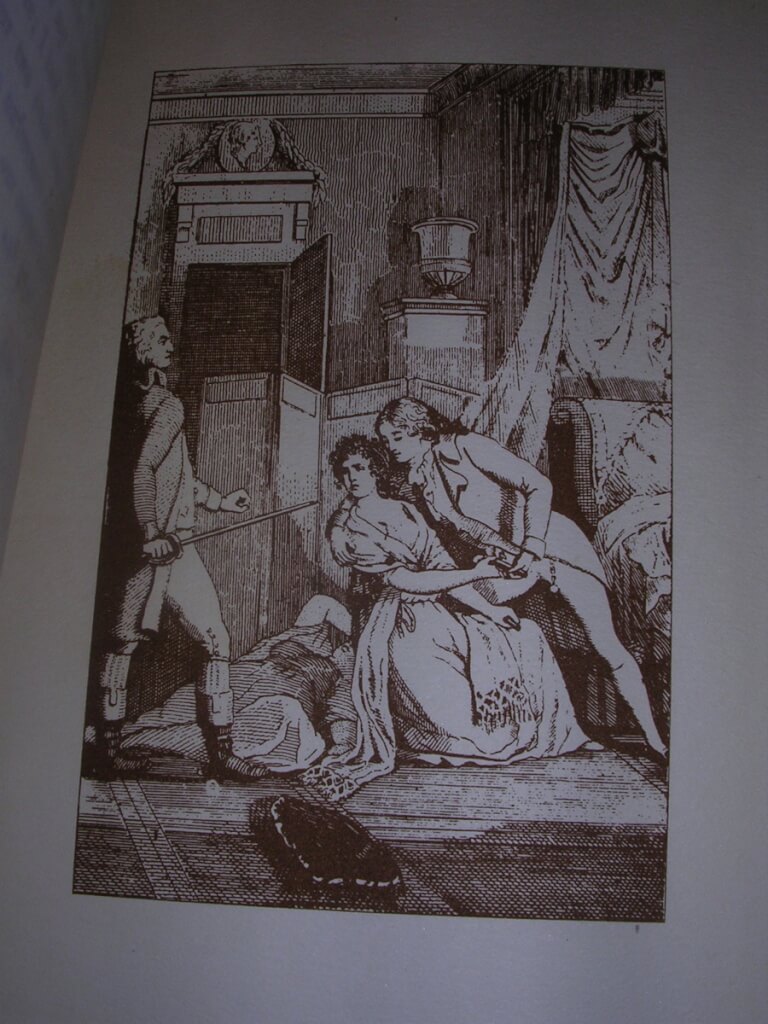
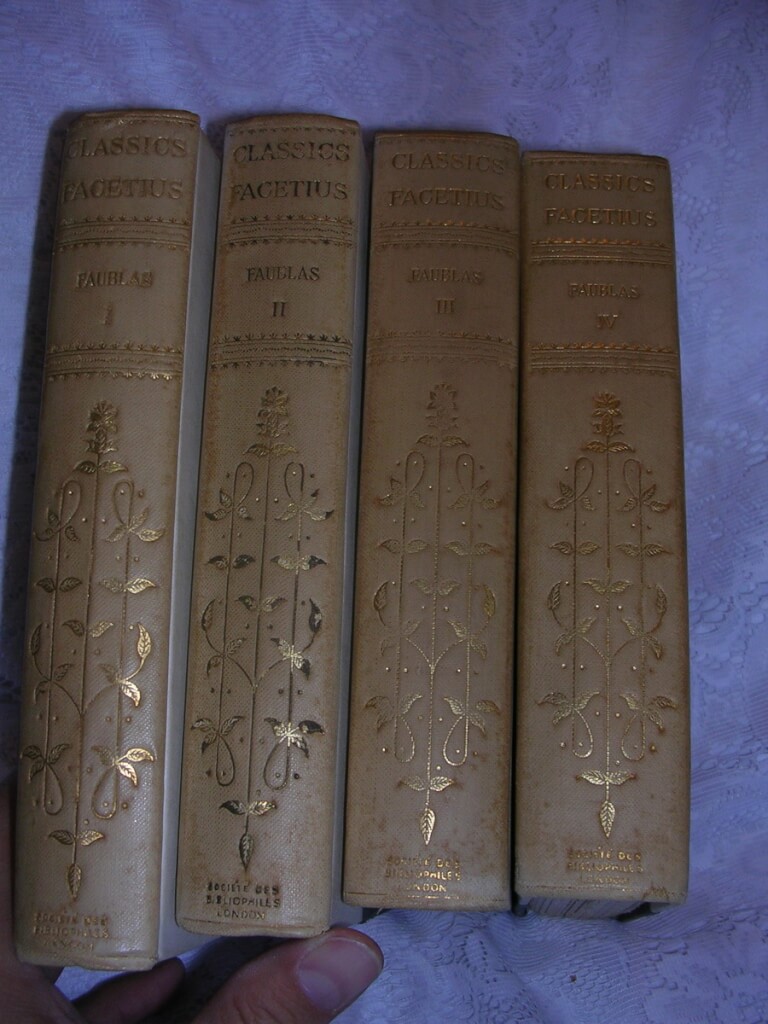 The Amours of the Chevalier de Faublas | by John Baptiste Louvet de Courvray | founded on historical facts, interspersed with most remarkable narratives | a literal unexpurgated translation from the Paris edition of 1821, etchings by Louis Monzies from drawings of Paul Avril (Privately Printed for Société des Bibliophiles [possibly Charles Carrington], London 1898, one of 100, first English translation edition) 5.75"x8.25", 4 volumes, ix+330pp, 367pp, 416pp, 430pp, white spine over green boards, gilt title ("Classics Facetius | Faublas") and decorations on spine, top edge gilt, others deckled, many pages unopened, spine slightly soiled, slight sunning, otherwise in excellent condition for age, numerous illustrations with titled tissue guards. This is the first English translation of this work which, when published was a "sensation" all over Europe. It appears to be published by Charles Carrington, who occasionally used the Société des Bibliophiles imprint and often used illustrations from Paul Avril. Édouard-Henri Avril (1849-1928) used the pseudonym "Paul Avril" for his erotic work. He was a French painter and commercial artist. His career saw collaboration with influential people like Octave Uzanne, Henry Spencer Ashbee and Friedrich Karl Forberg. He is one of the most celebrated erotic artists of his age. Avril was a soldier before starting his career in art. He was awarded with the Legion of Honour for his actions in the Franco-Prussian War. Jean-Baptiste Louvet de Couvrai (1760 - 1797) was born in Paris as the son of a stationer, he became a bookseller's clerk, and first attracted attention with the first part of his novel "Les Amours du chevalier de Faublas" (5 parts) in 1787; it was followed in 1788 by "Six semaines de la vie du chevalier de Faublas" (8 parts) and in 1790 by "La Fin des amours du chevalier de Faublas" (6 parts). The heroine, Lodoiska, was modeled on the wife of a jeweler in the Palais Royal, with whom he had an affair. She divorced her husband in 1792 and married Louvet in 1793. This is considered a so-called "libertine" novel. It dwells mainly on the sexual escapades of its hero, a sort of amiable young libertine, and on the corrupted morals of eighteenth-century France. At the start of this novel the young Chevalier de Faublas attends a party dressed as a woman and is knowingly seduced by the lady of the house ('. I receive with equal astonishment and pleasure a charming lesson, which I repeated more than once .') Oxford Comp. to French Literature says it is "typical of many frivolous, licentious novels of its time, and still mentioned. Faublas, the amiable hero, is the victim of his own charms. His amorous adventures, recounted with a certain lively force, begin with his entry into society at the age of sixteen. He loves several women by the way and three in particular. A jealous husband and a despairing suicide reduce the three to one. The novel ends on a moral note: Faublas , who had happened to settle down with his remaining love, is haunted by the avenging phantoms of the other two and goes mad."
The Amours of the Chevalier de Faublas | by John Baptiste Louvet de Courvray | founded on historical facts, interspersed with most remarkable narratives | a literal unexpurgated translation from the Paris edition of 1821, etchings by Louis Monzies from drawings of Paul Avril (Privately Printed for Société des Bibliophiles [possibly Charles Carrington], London 1898, one of 100, first English translation edition) 5.75"x8.25", 4 volumes, ix+330pp, 367pp, 416pp, 430pp, white spine over green boards, gilt title ("Classics Facetius | Faublas") and decorations on spine, top edge gilt, others deckled, many pages unopened, spine slightly soiled, slight sunning, otherwise in excellent condition for age, numerous illustrations with titled tissue guards. This is the first English translation of this work which, when published was a "sensation" all over Europe. It appears to be published by Charles Carrington, who occasionally used the Société des Bibliophiles imprint and often used illustrations from Paul Avril. Édouard-Henri Avril (1849-1928) used the pseudonym "Paul Avril" for his erotic work. He was a French painter and commercial artist. His career saw collaboration with influential people like Octave Uzanne, Henry Spencer Ashbee and Friedrich Karl Forberg. He is one of the most celebrated erotic artists of his age. Avril was a soldier before starting his career in art. He was awarded with the Legion of Honour for his actions in the Franco-Prussian War. Jean-Baptiste Louvet de Couvrai (1760 - 1797) was born in Paris as the son of a stationer, he became a bookseller's clerk, and first attracted attention with the first part of his novel "Les Amours du chevalier de Faublas" (5 parts) in 1787; it was followed in 1788 by "Six semaines de la vie du chevalier de Faublas" (8 parts) and in 1790 by "La Fin des amours du chevalier de Faublas" (6 parts). The heroine, Lodoiska, was modeled on the wife of a jeweler in the Palais Royal, with whom he had an affair. She divorced her husband in 1792 and married Louvet in 1793. This is considered a so-called "libertine" novel. It dwells mainly on the sexual escapades of its hero, a sort of amiable young libertine, and on the corrupted morals of eighteenth-century France. At the start of this novel the young Chevalier de Faublas attends a party dressed as a woman and is knowingly seduced by the lady of the house ('. I receive with equal astonishment and pleasure a charming lesson, which I repeated more than once .') Oxford Comp. to French Literature says it is "typical of many frivolous, licentious novels of its time, and still mentioned. Faublas, the amiable hero, is the victim of his own charms. His amorous adventures, recounted with a certain lively force, begin with his entry into society at the age of sixteen. He loves several women by the way and three in particular. A jealous husband and a despairing suicide reduce the three to one. The novel ends on a moral note: Faublas , who had happened to settle down with his remaining love, is haunted by the avenging phantoms of the other two and goes mad." -
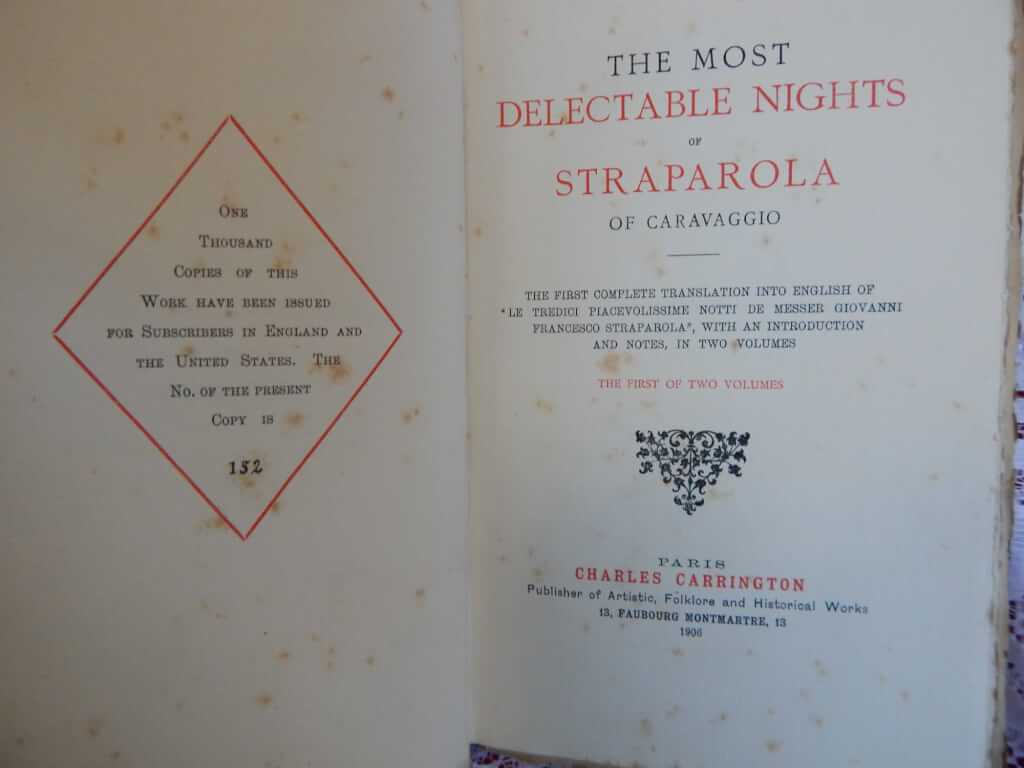
 The Most Delectable Nights of Straparola of Caravaggio, the first complete translation into english of "Le tredici piacevolissime notte, de Mesier Giovanni Francesco Straparola", with an introduction and notes, in two volumes, illust. by Léon Lebègue and Adolph Lambrecht (Charles Carrington, "Publisher of Artistic, Folklore and Historical Works", Paris, 1906, #152/1000, [first english translation, first edition] "Printed in Holland at the Printing Works of G. J. Thieme, Nymeguen.") 5.75"x8.5", 2 vol. xvi+352pp, xl+420pp, top edge gilt other edges deckled, blue boards with gilt borders and gilt lettering to the spines, red and black text and decorations throughout, numerous illustrations, both vignettes within text and tipped-in full color plates with descriptive tissue guards, handsome good+ copy for age, some foxing, small tear at top of vol. 1 spine, slight sunning to boards. This is a rare, beautifully executed, 1st edition, 1st English translation, 1st printing, low number limited edition, by Charles Carrington. Giovanni Francesco "Gianfrancesco" Straparola, also known as Zoan or Zuan Francesco Straparola da Caravaggio (1485?-1558) was a writer of poetry, and collector and writer of short stories. Some time during his life, he migrated from Caravaggio to Venice where he published a collection of stories in two volumes called Le piacevoli notti (1551 and 1553) (The Pleasant Nights, first translated by W. G. Waters in 1901 as "The Facetious Nights"). The Pleasant Nights is the work for which Straparola is most noted, and which contains a total of seventy-five short stories, fables, and fairy tales. The tales, or novelle, are divided into Nights, rather than chapters, and resemble the type of narrative presentation found in Boccaccio's Decameron. This presentation is of a gathering of Italian aristocrats, men and women, who entertain themselves by singing songs, dancing, telling stories and presenting enigmas (riddles). The Pleasant Nights contains many different types of tales, including realistic novellas, stories about practical jokes, tragic and triumphant love stories, bawdy tales, and animal stories. Some sixteen of these 74 tales are fairy tales including the story of Puss-in-Boots, the story of an impoverished boy whose enchanted cat earns him wealth, marriage to a princess, and a kingdom. Among the other fairy tales in The Pleasant Nights, we find a dragon slayer tale; the tale of a prince born in the shape of a pig due to a fairy’s curse who regains his human form only after marrying three time,; the story of Biancabella or “White Beauty” a princes who undergoes many trials until finally being saved by a fairy; and the a poor girl who acquire a magic doll that poops money and helps her marry a prince. It is claimed that many of the stories within The Pleasant Nights had been taken from earlier works, specifically from Girolamo Morlini, a 15th/16th century lawyer from Naples. If taken at his word, Straparola never denied this. In the Dedication at the front of the second volume, Straparola wrote that the stories ". . . written and collected in this volume [vol. 2 only?] are none of mine, but goods which I have feloniously taken from this man and that. Of a truth I confess they are not mine, and if I said otherwise I should lie, but nevertheless I have faithfully set them down according to the manner in which they were told by the ladies, nobles, learned men and gentlemen who gathered together for recreation."
The Most Delectable Nights of Straparola of Caravaggio, the first complete translation into english of "Le tredici piacevolissime notte, de Mesier Giovanni Francesco Straparola", with an introduction and notes, in two volumes, illust. by Léon Lebègue and Adolph Lambrecht (Charles Carrington, "Publisher of Artistic, Folklore and Historical Works", Paris, 1906, #152/1000, [first english translation, first edition] "Printed in Holland at the Printing Works of G. J. Thieme, Nymeguen.") 5.75"x8.5", 2 vol. xvi+352pp, xl+420pp, top edge gilt other edges deckled, blue boards with gilt borders and gilt lettering to the spines, red and black text and decorations throughout, numerous illustrations, both vignettes within text and tipped-in full color plates with descriptive tissue guards, handsome good+ copy for age, some foxing, small tear at top of vol. 1 spine, slight sunning to boards. This is a rare, beautifully executed, 1st edition, 1st English translation, 1st printing, low number limited edition, by Charles Carrington. Giovanni Francesco "Gianfrancesco" Straparola, also known as Zoan or Zuan Francesco Straparola da Caravaggio (1485?-1558) was a writer of poetry, and collector and writer of short stories. Some time during his life, he migrated from Caravaggio to Venice where he published a collection of stories in two volumes called Le piacevoli notti (1551 and 1553) (The Pleasant Nights, first translated by W. G. Waters in 1901 as "The Facetious Nights"). The Pleasant Nights is the work for which Straparola is most noted, and which contains a total of seventy-five short stories, fables, and fairy tales. The tales, or novelle, are divided into Nights, rather than chapters, and resemble the type of narrative presentation found in Boccaccio's Decameron. This presentation is of a gathering of Italian aristocrats, men and women, who entertain themselves by singing songs, dancing, telling stories and presenting enigmas (riddles). The Pleasant Nights contains many different types of tales, including realistic novellas, stories about practical jokes, tragic and triumphant love stories, bawdy tales, and animal stories. Some sixteen of these 74 tales are fairy tales including the story of Puss-in-Boots, the story of an impoverished boy whose enchanted cat earns him wealth, marriage to a princess, and a kingdom. Among the other fairy tales in The Pleasant Nights, we find a dragon slayer tale; the tale of a prince born in the shape of a pig due to a fairy’s curse who regains his human form only after marrying three time,; the story of Biancabella or “White Beauty” a princes who undergoes many trials until finally being saved by a fairy; and the a poor girl who acquire a magic doll that poops money and helps her marry a prince. It is claimed that many of the stories within The Pleasant Nights had been taken from earlier works, specifically from Girolamo Morlini, a 15th/16th century lawyer from Naples. If taken at his word, Straparola never denied this. In the Dedication at the front of the second volume, Straparola wrote that the stories ". . . written and collected in this volume [vol. 2 only?] are none of mine, but goods which I have feloniously taken from this man and that. Of a truth I confess they are not mine, and if I said otherwise I should lie, but nevertheless I have faithfully set them down according to the manner in which they were told by the ladies, nobles, learned men and gentlemen who gathered together for recreation." -
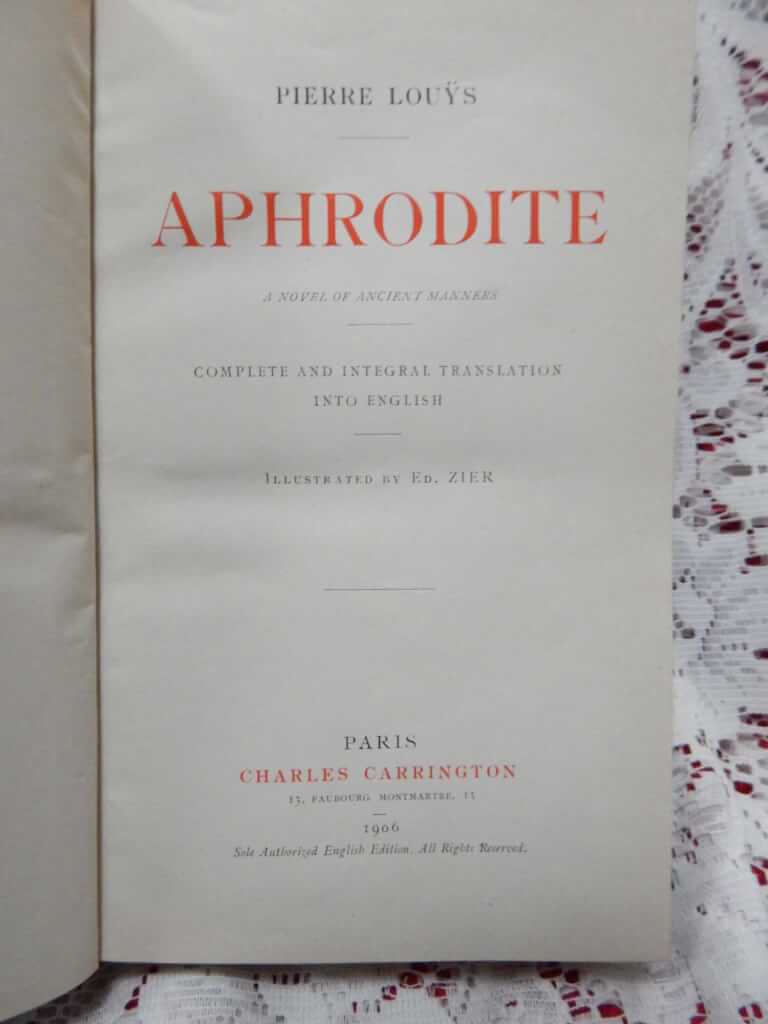
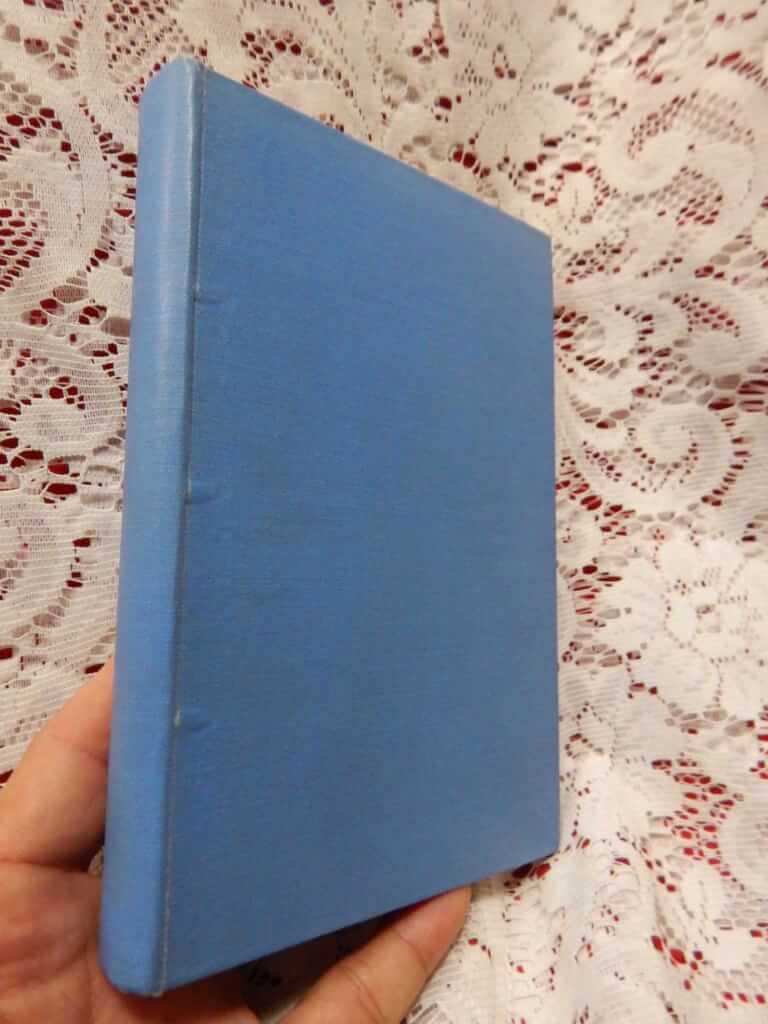 Aphrodite, a novel of ancient manners, by Pierre Louÿs, illus. Ed. Zier (Charles Carrington, 1906, first edition thus, first English translation) 5.25 x 7.75", xiv+412pp, rebound with plain blue boards, fine condition Pierre Louys (1870 - 1925) was a French poet and writer, most renowned for lesbian and classical themes in some of his writings. He is known as a writer who "expressed pagan sensuality with stylistic perfection." "Aphrodite: mæurs antiques" (Ancient Manners) is a "libertine" story set in ancient Alexandria. Highlights include the loves of Chrysis, an orgy banquet ending in the crucifixion of a slave, the love of two young musician girls and the festivals of Aphrodite. "This Translation of Aphrodite was executed on the Printing Presses of Charles Herissey, at Evreux (France), for Mr. Charles Carrington, Paris, Bookseller et Publisher, and is the only complete English version extant." Édouard François Zier (1856-1924) was a French illustrator and painter.
Aphrodite, a novel of ancient manners, by Pierre Louÿs, illus. Ed. Zier (Charles Carrington, 1906, first edition thus, first English translation) 5.25 x 7.75", xiv+412pp, rebound with plain blue boards, fine condition Pierre Louys (1870 - 1925) was a French poet and writer, most renowned for lesbian and classical themes in some of his writings. He is known as a writer who "expressed pagan sensuality with stylistic perfection." "Aphrodite: mæurs antiques" (Ancient Manners) is a "libertine" story set in ancient Alexandria. Highlights include the loves of Chrysis, an orgy banquet ending in the crucifixion of a slave, the love of two young musician girls and the festivals of Aphrodite. "This Translation of Aphrodite was executed on the Printing Presses of Charles Herissey, at Evreux (France), for Mr. Charles Carrington, Paris, Bookseller et Publisher, and is the only complete English version extant." Édouard François Zier (1856-1924) was a French illustrator and painter.


